Music is the universal language
“Glory to God in the highest heaven, and on earth peace to those on whom his favor rests.” - Luke 2:14
Premier Guitar
Electro-Harmonix Releases the Pico Swello Attack Envelope
Electro-Harmonix is excited to introduce the Pico Swello Attack Envelope pedal. Inspired by the legendary POG2 ATTACK slider, the core effect of the Swello is a polyphonic attack filter which applies individual volume swells to each note you played, even within chords and through sustained arpeggios. This unique effect is paired with an adjustable Low Pass Filter for smooth swells and envelope filter-style effects.
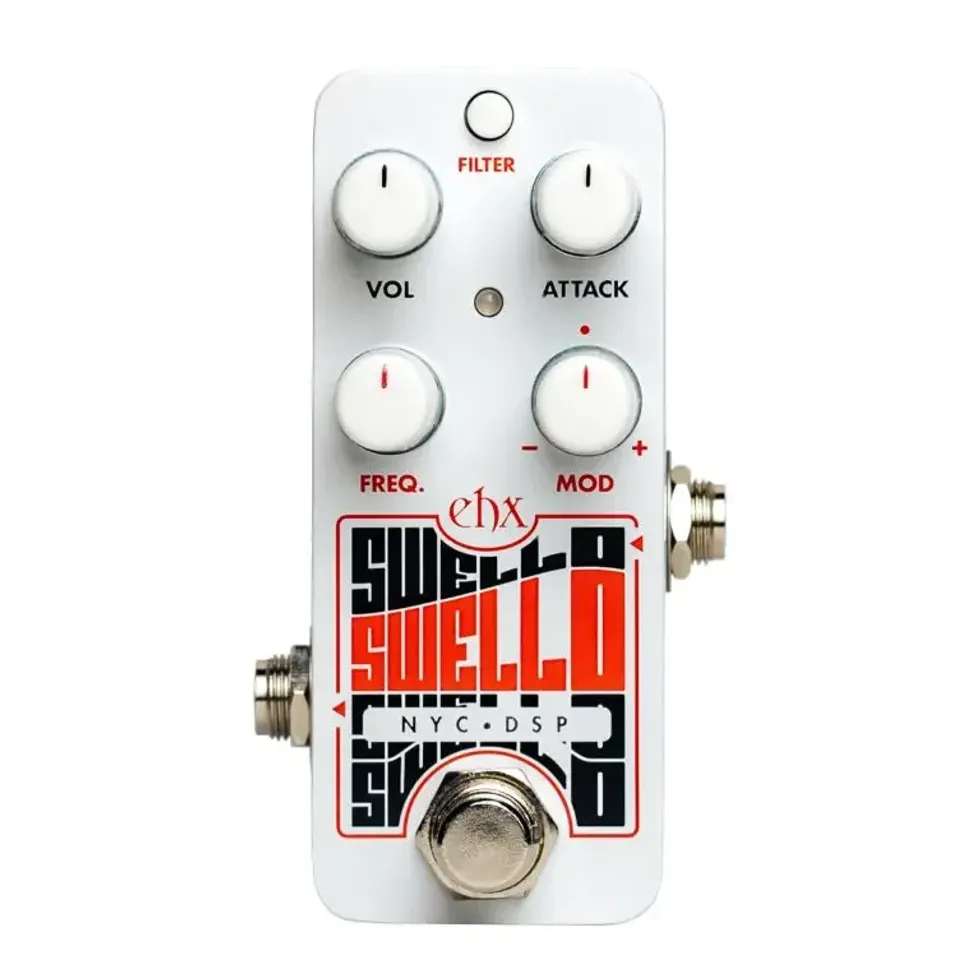
Housed in EHX’s Pico-sized chassis, the Swello has a simple four knob/one button layout. VOL adjusts the overall output of the pedal while ATTACK sets the attack envelope time. Low ATTACK settings attenuate just the initial attack of your instrument, while higher settings offer epic, long note swells. The Low Pass Filter is controlled by the FILTER button as well as the FREQ and MOD knobs. FILTER engages the LPF and applies an adjustable high or low resonance setting. The FREQ knob sets the cutoff frequency of the LPF and the MOD knob controls the depth and direction of the filter modulation akin to an envelope filter. Turn MOD up from noon for an upward filter sweep or down from noon for a downward filter sweep.
The EHX Pico Swello comes equipped with a standard EHX 9 Volt power supply. It will be available Mid-September and features a U.S. Street Price of $149.50.
New Michael Schenker Group Album "Don’t Sell Your Soul," Out Oct. 3
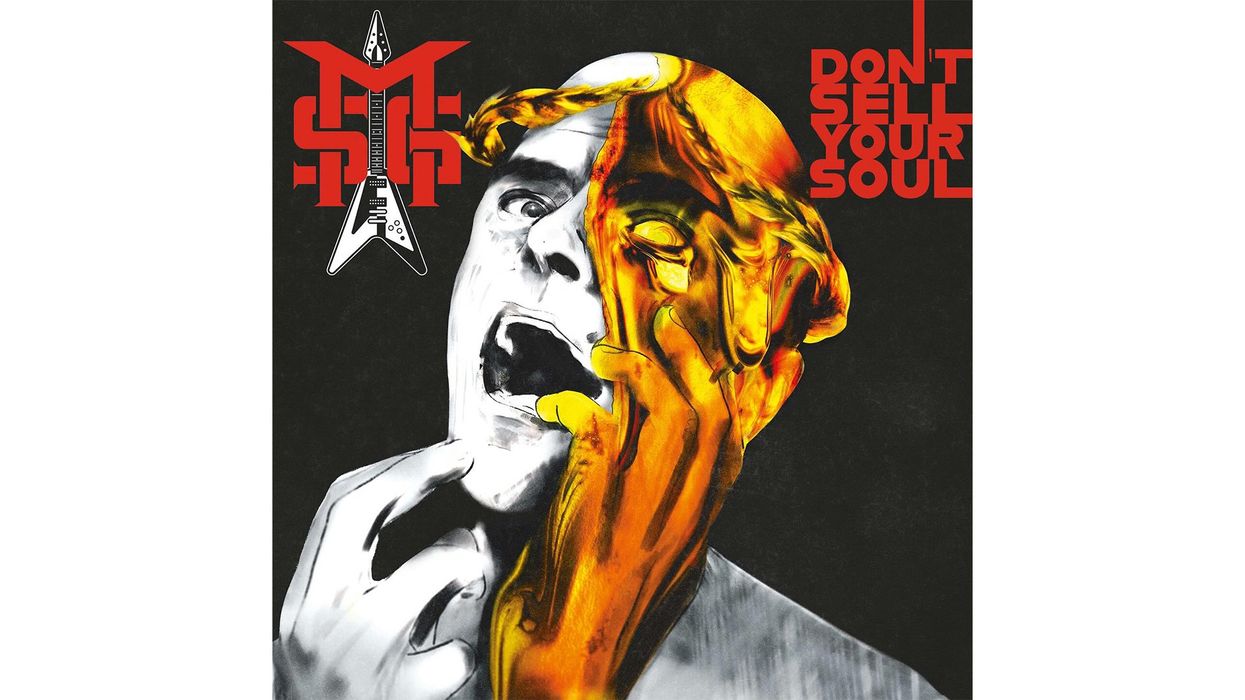
What was already a standout moment of this year's Wacken Open Air, the world's largest metal festival, turned into something even bigger when legendary guitarist Michael Schenker pulled a surprise no one saw coming. The architect of hard rock used the world's loudest stage to announce that a brand new Michael Schenker Group studio album, titled Don't Sell Your Soul, will be released on October 3 via earMUSIC.
To mark the occasion, Schenker and his band closed the show with a world-exclusive live premiere of the new album's title track — a powerful encore that took the Wacken crowd by surprise and was met with instant enthusiasm on the muddy festival fields. You can now listen to the new track HERE.
- Don't Sell Your Soul is the second part of an album trilogy that began with 2024's My Years With UFO. This will be the first studio album for MSG since Universal in 2022.
- The album was produced by Michael Schenker and Michael Voss, and recorded with Schenker's longtime allies: Bodo Schopf (drums), Barend Courbois (bass), and Steve Mann (guitar, keys). On vocals: the impeccable Erik Grönwall (Skid Row, H.E.A.T) – undoubtedly one of the finest rock voices of his generation. Guest appearances on vocals by Robin McAuley, Dimitri "Lia" Liapakis, and Michael Voss round out the cast.
- The Michael Schenker Group was formed in 1979 and has released 12 studio albums with many different members over the years, with Schenker the only constant presence.
- Michael Schenker played in the rock band UFO and leads the Michael Schenker Group (MSG). He was an early member of the hard rock band Scorpions, a band co-founded by his elder brother Rudolf Schenker.
- Michael Schenker is regarded as one of the most influential guitarists of the 1970s, and is widely known as a legendary figure in the history of metal guitar.
Michael Schenker is an undisputed living legend and it is time to sell your soul with MSG. Let us know what you think! Michael IS doing a limited amount of interviews so let's talk and see what we can set up!
Wah-Wah 101
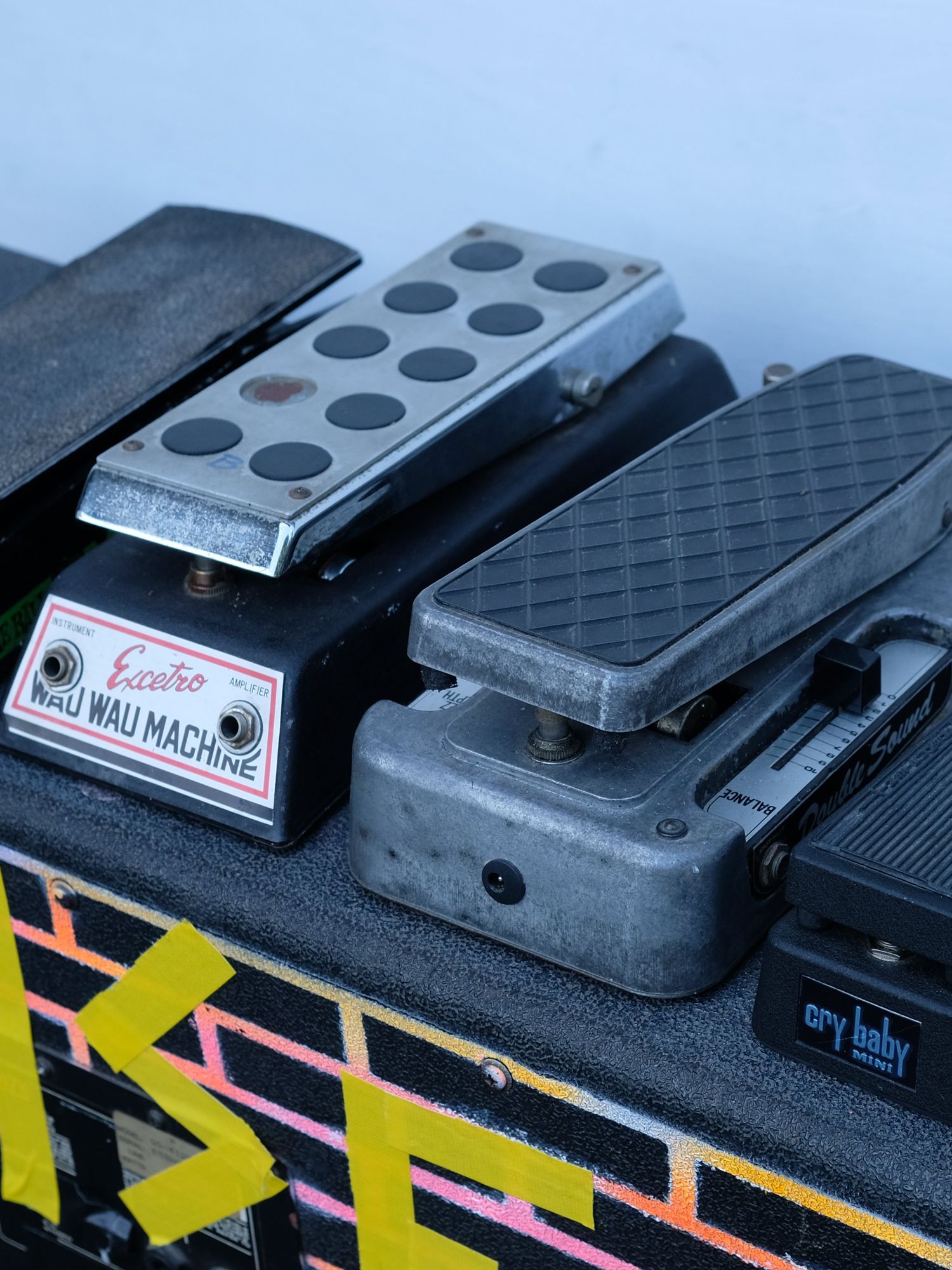
If you ask me what my favorite pedal is after fuzz, the answer is definitely wah. Bands like Fu Manchu and Dinosaur Jr. are great examples of just how powerful wah, fuzz, and a wall of amps can sound together. Sorry, I’m not into SRV voodoo or those “whacka-whacka” kinds of wah sounds.
Let’s dig a little deeper. My very first wah pedal was actually a gift from my ex-girlfriend. She told me it sounded “sexy.” She knew absolutely nothing about guitars. Maybe the sound reminded her of some sleazy ’70s B-movie soundtrack. That pedal was a Dunlop GCB95 with a red Fasel inductor. I absolutely loved it … at first. I even took it out on tour. But I grew to hate it. It was heavy, hard to click on, had no on/off LED, and it sucked tone like crazy. But still, it was the pedal that made me fall in love with wah and start digging deep into its history.
Wah is one of the most iconic effects pedals—so iconic that even non-guitarists recognize it instantly by sound alone. Hence the name—wah. The effect was first developed around 1964 by the Thomas Organ Company, an American distributor of Vox products from the U.K. Their goal? Originally, it was intended for use with Vox organs, to mimic a trumpet-like tone. Bradley J. Plunkett, a junior engineer at Thomas, modified a midrange booster circuit and eventually decided to use a potentiometer as a frequency control. The result was essentially a variable band-pass filter, initially released as the Clyde McCoy Wah-Wah. McCoy was a trumpet player, and that product was intended to achieve a muted-trumpet effect with guitar. In 1967, to better appeal to guitarists, the name was changed to the Cry Baby, although in Italy Vox branded the device as the V846 Wah-Wah—and the rest is history.
As the music industry evolved, so did the wah pedal. Both the sound and the mechanism used to operate wah pedals went through significant changes. The original Vox V846 used a variable band-pass filter housed in an organ volume pedal enclosure, where the potentiometer was turned via a gear. This allowed players to control the frequency range with a rocking foot motion. This design is still used today by many manufacturers.
However, that system has its drawbacks. Over time, the gears wear out due to friction. Then, there’s the issue of limited sweep range: most rotary pots have about 270 degrees of rotation, but gear mechanisms often only utilize about a third of that, making them far from optimal. In 1977, Ernie Ball replaced the gear mechanism with a string-loop-and-spring design, allowing for a full and smooth sweep. Roland and Boss also introduced unique approaches, including automotive-like axle designs and pedal mechanisms inspired by bicycle cranks—equally effective and efficient. Morley, meanwhile, took a more futuristic approach by employing optical sensors to control the sweep, with no moving interior parts at all.
“Perhaps due to their legacy tones, many players enjoy the limitations of the original design.”
Despite these innovations, no single mechanism has rendered the others obsolete. In the end, it’s up to the musician—the user—to decide which design works best for their playing style and live performance needs. I find myself more comfortable with devices like the one from Ernie Ball, simply because they include an LED indicator. I also really love the Dunlop Bass Wah—essentially a manual envelope filter—which I think is genius.
That said, the classic gear-style wah pedals still have their loyal fans. Perhaps due to their legacy tones, many players enjoy the limitations of the original design. I still believe the lack of an on/off LED indicator is the biggest flaw in traditional wahs like the Cry Baby or Vox models.
Maybe I’m just one of those people with unorthodox tastes and needs. I don’t claim to be special or different, but wah pedals are tools for making music, and music-making is by nature a subjective process. And that’s totally okay, right?
In fact, I’m sure many of the innovations we’ve seen in wah pedal design come from the designers’ own subjectivity—trying to solve real problems they perceive in real contexts. As long as people are passionate about making music, new ideas will keep emerging. Weird, wonderful, and always evolving—that’s wah.
Bass Legends’ Pedalboards: Justin Chancellor, Tim Commerford, MonoNeon and more!
Re-live classic Rig Rundowns from Tool’s Justin Chancellor, Pantera’s Rex Brown, Tim Commerford (RATM/Prophets of Rage), MonoNeon (Prince), and other road-tested pros as they reveal the routing, wah/whammy tricks, delay math, and looping workflows that truly hold up onstage.
Watch the FULL Rig Rundowns:
Tool’s Justin Chancellor: https://www.youtube.com/watch?v=OlbvMpq4C64
Pantera’s Rex Brown: https://www.youtube.com/watch?v=GYPG6SQlupQ
Donny Benet: https://youtu.be/WHR5aPTYs4E
MonoNeon: https://youtu.be/fjHgrc06Ov8
Blu DeTiger: https://youtu.be/gVLSMnVID4Q
Tim Commerford: https://www.youtube.com/watch?v=JsgUqLdgQ1U
El Ten Eleven: https://youtu.be/3wpkBijUkok
Brought to you by D’Addario: https://ddar.io/wykyk-rr
Join D’Addario’s Players Circle for free today to start earning points toward free gear: https://ddar.io/pc-rr Noise Engineering Batverb Review
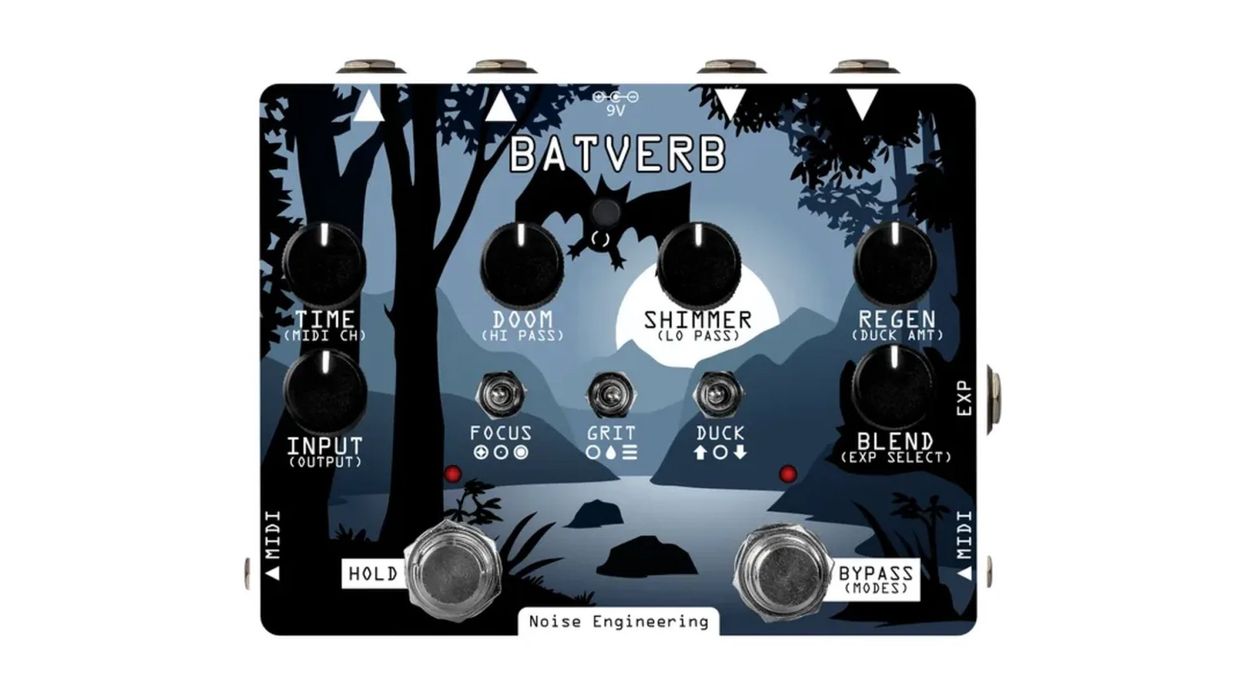
When California-based effects company Noise Engineering released their Desmodus Versio in 2020, it represented the first reverb effect in their product line, but they coined a new term for the DSP-based effect: a synthetic-tail generator. The name reflects the reality that it is, by definition, the Desmodus Versio doesn’t create literal reverberation, as in reflections in a room, but instead builds “tails” onto an audio signal. Taxonomy aside, it was a powerful, well-received, and positively jam-packed digital unit.
The Batverb, launched earlier this year, is an evolution of Noise’s tail-generating efforts. However, it uses brand-new code programmed for Electrosmith’s Daisy Seed DSP platform. A stereo effect box that spans delightful and demented flavors of delay and reverb, the Batverb is generously featured and full of unique takes on space-making effects.
Heads or Tails
The Batverb’s main panel includes six knobs, three 3-way switches, two footswitches, and one “bat” button, which you press and hold to access alternate parameters assigned to the knobs. On the crown are input jacks for either mono or stereo performance as well as MIDI in/out and expression pedal jacks. Up to 16 different presets can be saved and recalled via MIDI.
In normal operation, the knobs govern, from bottom left to bottom right, input volume, time, a suboctave chorus, an octave-up shimmer, “regen” or feedback, and a blend of dry and wet signals. When holding the bat button, those same knobs, in order, control output volume, MIDI channel selection, high-pass filter, low-pass filter, duck amount, and expression pedal parameter assignment. The focus switch changes the diffusion of the delay lines. In the left position it behaves more like a delay, while the other two settings sound and feel more like reverbs. Grit adds, in the middle and right positions, a discrete soft-clipping distortion, and duck determines the responsiveness of the feedback. In the switch’s center position, there’s no ducking. At left, feedback monetarily increases when input volume is received, then tapers off as the signal does. At right, the opposite happens, and feedback increases as the signal gets quieter.
Enter the Bat Cave
To my ears, the Batverb’s more reverb-y patches are in hall or room territory—albeit very cavernous halls or rooms. But reverb sounds created by the Batverb’s algorithms sound more authentic to me than many sought-after reverbs I’ve played. Rather than an indistinct wash of sound, the tails here give the convincing impression of your amp’s signal ricocheting around a high-ceilinged cathedral, at first coming back in clearer, sharper bursts, then melting into smeary ambience. And the handy hold feature can be engaged for infinite regeneration by tapping the footswitch, or for a specific window by pressing and holding. That double utility goes a long way toward determining whether the Batverb sounds organic or unhinged.
The sub- and up-octave content injected by the doom and shimmer knobs is more chaotic and spacious than garden-variety iterations of those effects you’ll find on many octave-based reverbs, and that’s a good thing. Like most effects generated by the Batverb it feels like the product of thoughtful, well-considered programming.
The delay algorithm, engaged with the focus toggle at left, is pleasant and plenty usable, and it’s nice to have alongside the less predictable reverb settings. But the Batverb’s deep tweakability means you can still dial in a broad range of both standard and more marginal delay sounds. The chunky transistor-ish dirt summoned by the grit switch widens the palette further. Add in the touch-sensitive ducking (and its customizable parameters), and you’ve got a ton of ground to play with.
The Verdict
Noise Engineering created an outstanding reverb and tail generator here. Considering its steep asking price, the Batverb will be out of the question for many players, but it’s obviously geared to adventurous players and discerning producers, especially those looking for authentic, parallel universe-conjuring ambience and noise in their studio or live rigs. For these musicians, the Batverb will be more than worth the bite it takes from the bank balance.
Filmmaker and Musician Jim Jarmusch on Guitars, Music, & Magic
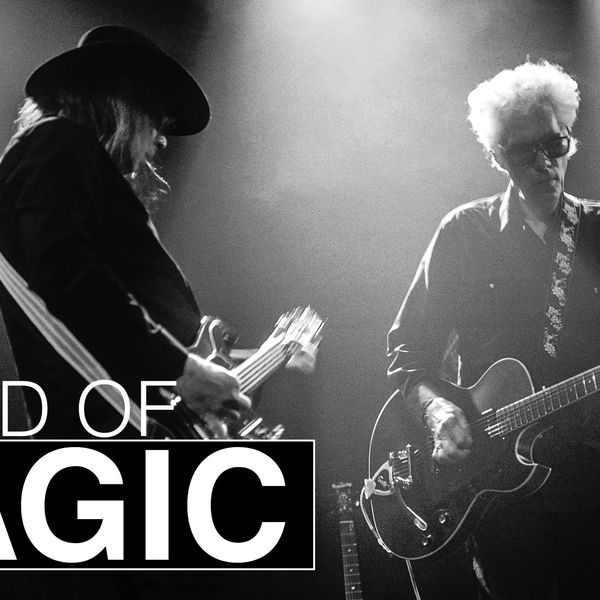
Filmmaker Jim Jarmusch—one of the creative avatars of downtown New York cool since the mid ’80s—was asked a while back what he thought were some of the key innovations of the 20th century. “My answer was the mapping of the human genome, the Hubble Space Telescope, the French bikini, and the electric guitar,” recalls the director of such arthouse wonders as Mystery Train, Dead Man, and Only Lovers Left Alive. “My favorite of those might be the electric guitar. I just love guitars and musical noise.”
YouTube
Jarmusch isn’t just a fan of music ranging from the Stooges and Crazy Horse to heavy drone bands like Earth and Nadja. He generates guitar noise himself, most notably with his band Sqürl and his frequent duo partner, the Dutch lutenist Jozef van Wissem. Jarmusch has been making records and performing live with both for years now; his output with a guitar in hand has even lately outpaced his productivity behind a camera. Last year, he and his prime Sqürl mate, Carter Logan (drums/electronics), released Music for Man Ray, an album of their scores to Surrealist short films made by the titular artist in the 1920s, the whorls of sound captured live at the Centre Pompidou in Paris. That disc followed a 2023 Sqürl studio album, Silver Haze, with guest stars guitarist Marc Ribot, actress/vocalist Charlotte Gainsbourg, and the singer-songwriter Anika. Jarmusch and van Wissem toured this summer to herald a new record, The Day the Angels Cried, their fifth non-soundtrack release. Jarmusch has also been working on some longform solo guitar music, asking the recording engineer to “edit out all the riffs” as he follows a dream-logic muse.
“You have to be listening and use your whole body along with your instrument, your amps, your effects. But what you’re going to produce isn’t certain, and there’s tension in that.”—Jim Jarmusch
Although he had played in bands during the early ’80s, mostly on keyboards, Jarmusch took up the guitar as a passion in the early 2000s. He had planned for his pensive noir The Limits of Control (2009) to feature preexisting music rather than a purpose-written score, including viscous art-metal by Boris, Sunn O))), and Earth, the tolling psychedelic rock of the Black Angels’ “You on the Run,” and a handful of flamenco pieces to suit the Spanish setting. But when he couldn’t find the right tracks to match some elemental sounds he heard in his head for a few remaining scenes, Jarmusch decided to make that music himself, alongside Logan and engineer-organist Shane Stoneback. Credited as Bad Rabbit on the soundtrack, the name morphed into Sqürl as Jarmusch and Logan released further recordings, such as the luminous, affecting Some Music for Robby Müller (a sonic tribute to the late, great cinematographer).
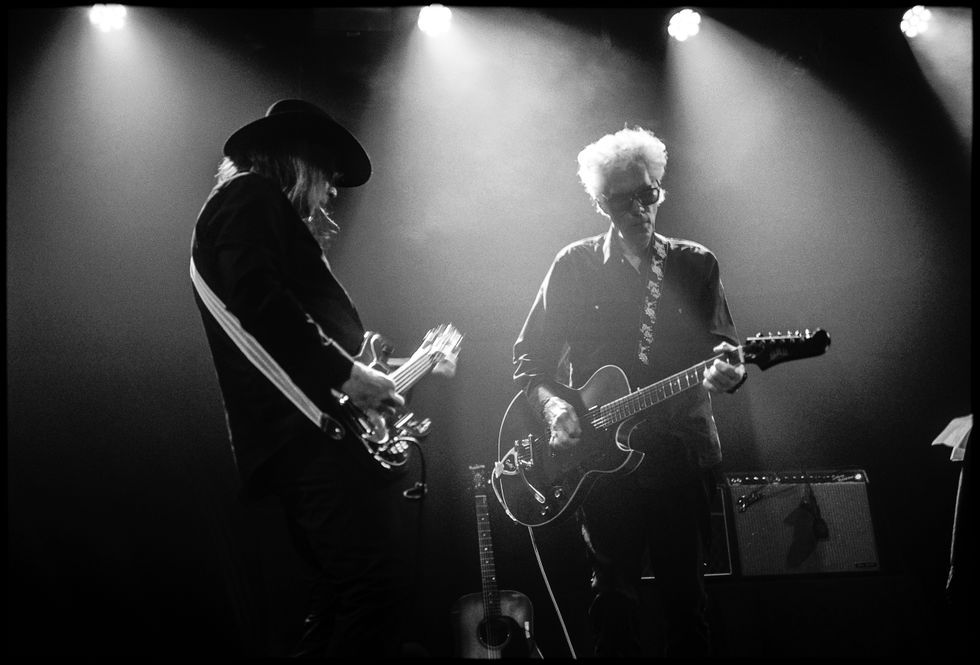
“I’m not a trained guitar player—never even had a real lesson,” explains Jarmusch, 72. “I play my own way. I don’t practice scales, but something I have practiced for many years is controlled feedback. If I can say anything, it’s that I’ve become pretty good at that kind of musical feedback on electric guitar, something I do a lot in the duo with Jozef. I have had some pointers in this area, particularly from Stephen O’Malley from Sunn O))) and Stewart Hurwood, one of Lou Reed’s guitar techs. But the thing about feedback is that you’re not always totally in control of it. You don’t know exactly how the guitar and pickups are going to react vis-à-vis what distance you are from the amplifiers and how their levels are set. So, you have to be listening and use your whole body along with your instrument, your amps, your effects. But what you’re going to produce isn’t certain, and there’s tension in that. I’m always interested in the challenge of being a little off-balance—it inspires me. I’m not so good at repeating a formula, as I’m not mathematical in that way. When playing more rock ’n’ roll guitar with Sqürl, I can even sort of frustrate Carter at times, because he’s a precise drummer and my approach is on the loose side.
Primal Sounds, Old Wood
When it comes to his ethos of guitar, clues come from the two documentaries Jarmusch has made: the exciting, insightful Stooges history Gimme Danger (2016) and the lo-fi road document Year of the Horse, which Neil Young called “a nature film” of his 1996 tour with Crazy Horse. “I’m definitely not into shredding, even if you can admire the technical mastery of someone like Eddie Van Halen,” Jarmusch says. “I’m a Ron Asheton guy—in the more primal camp. I really like Neil’s raw style. I’m drawn to players who approach the instrument from an odd slant.” He points to Ribot, Link Wray, Robert Quine, and Rowland S. Howard of the Birthday Party as other individualists he finds inspiring, along with Earth’s Dylan Carlson for “his beautiful sound and incredible control” at glacial tempos, and Pat Place of the Contortions and Bush Tetras, “who brought such a funky vibe to the post-punk and No Wave scene in New York.”
Jarmusch lights up at memories of witnessing Television live, calling the interplay of Tom Verlaine and Richard Lloyd “a beautiful revelation—this weaving of guitars that wasn’t necessarily blues-based. Their shows would just elevate me to the sky.” He also digs the live-wire, sui generis guitar weave of Ibrahim Ag Alhabib and his mates in the nomadic Saharan band Tinariwen, as well as the drone-metal pairing of O’Malley and Greg Anderson in Sunn O))) and the intrepid avant-rock of Sonic Youth’s Thurston Moore and Lee Ranaldo.
Jim Jarmusch’s Gear
Guitars
Fender Stratocaster modified by Rick Kelly with Seymour Duncan Quarter Pound pickups, Callaham bridge, and leather pickguard by Cindy Guitars
Rick Kelly T-style
Guild Starfire I Jet 90 with three P-90 pickups
Fender Ed O’Brien Stratocaster
Epiphone Casino
Epiphone ES-335
Fender Jaguar
Blueridge Dreadnought
Gibson L-1
Guild mahogany dreadnought 12-string acoustic
Gretsch Bobtail Roundneck Resonator G9220
1960 Silvertone Jupiter
Amplifiers
Vox AC15
Fender Pro Junior
Roland Jazz Chorus
Silvertone 1482
Vox Pathfinder 15R
Effects
EarthQuakerDevices Dispatch Master
EarthQuakerDevices Avalanche Run
EarthQuakerDevices Transmisser
EarthQuakerDevices Astral Destiny
EarthQuakerDevices Hizumitas
EarthQuakerDevices Spires
EarthQuakerDevices Special Cranker
EarthQuakerDevices Aqueduct
EarthQuakerDevices Rainbow Machine
EarthQuakerDevices Warden
EarthQuakerDevices Acapulco Gold
Death by Audio Echo Master
Gamechanger Audio Plus Sustain
Gamechanger Audio Plasma
Electro-Harmonix Deluxe Memory Man (vintage)
Electro-Harmonix Pitchfork
Electro-Harmonix 720 Looper
Electro-Harmonix Voodoo Lab Overdrive
Boss Super Overdrive SD-1
Boss Compression Sustainer CS-3
Boss Loop Station RC-3
Boss Space Echo RE-20
Boss Catalinbread Echorec
MXR Carbon Copy
Chase Bliss Mood
Chase Bliss Generation Loss
Kernom Moho Fuzz
Dunlop TS-1 Stereo Tremolo
TrueTone CS12
Death By Audio Raw Power
Strings
D’Addario .010s

Like some of his favorite players, Jarmusch’s go-to shop is Carmine Street Guitars in New York’s West Village, whose customers have also included Quine, Ribot, Lou Reed, Bill Frisell, Nels Cline, and Lenny Kaye. The proprietor, Rick Kelly, is a luthier whose specialty is creating guitars made out of rare, especially resonant 19th-century wood sourced from New York City buildings, including McSorley’s Ale House (established in 1854) and the roof of Jarmusch’s Bowery loft. He calls Kelly “my main guy—a real artisan and just fascinating to talk with about guitars, tonewoods, everything.” Kelly built Jarmusch a custom T-style (with a wide-range humbucker at the neck), along with modifying his longtime road guitar for Sqürl: a black Stratocaster, with Seymour Duncan Quarter Pound pickups and other touches. Jarmusch appreciates the store’s old-school, workshop vibe so much that he encouraged a documentarian friend of his, Ron Mann, to make a charmer of a film called Carmine Street Guitars, which features Jarmusch and many of the aforementioned players stopping in to talk about the shop’s instruments and try them out.
“Making a film is a complex process with a lot of equal talents all pulling together, yet I’m necessarily the captain of the ship, navigating an idea from my imagination onto the screen. But when I’m making music with other people, I’m in a conversation.”
Jarmusch’s other favored guitars include a Blueridge dreadnought and an Ed O’Brien signature model Stratocaster. “The Ed O’Brien Strat with that Fernandes Sustainer unit is an amazing guitar, kind of trippy,” he says. “Whenever I pull that thing out in my little studio, the instrument almost starts playing itself, like it just wants you to experiment with it.” For the squalling counterpoint he provides to van Wissem’s circular arpeggios, Jarmusch switches to a semi-hollow guitar. “I have a cool 335-style Epiphone from the 1990s that feeds back beautifully, sounding like a cello. I played it for almost all the past recordings where I used feedback a lot. But for my latest tour with Jozef, I have been using a Guild Starfire Jet that has three P-90 pickups. It’s kind of a beast, but I’m loving it, because it’s very good for controlled feedback.”
Analog Spirit, Drone Power
About Jarmusch’s romance with guitars, van Wissem says, “I guess it was sort of an accident that the guitar and music became a bigger and bigger focus for Jim, but I always had the idea that he really wanted to be a musician, in a way. He has definitely become a good guitarist now, having developed his own sound and approach over the years. He loves his pedals and playing wild electric stuff and feedback, but he likes playing acoustic, too. We can go from darkly beautiful, even elegant things to some pretty metal sounds, especially at the climax of these recent shows when I trade the amplified lute for a 12-string guitar, my Gretsch Electromatic.”
Jarmusch and van Wissem hit it off after meeting on the street in SoHo about 20 years ago. “We immediately discovered that we shared an enthusiasm for many of the same films and books, and music from Morton Feldman to Joy Division,” van Wissem recalls. “Jim is a cultural sponge—he takes everything in.” The two developed a synergistic association, performing around New York with their unique combination of instruments and making records often colored by van Wissem’s arcane, neo-gothic mythos. The lutenist, playing models made for him by Canadian luthier Michael Schreiner after Renaissance and Baroque examples, had already been recording his own minimalist, contemplative compositions solo, having eschewed a traditional route of playing the complex classical repertoire (despite a love for such Baroque lutenist-composers as Sylvius Leopold Weiss). The aim, van Wissem says, was to “dust off” the lute by putting its intimate tones in a new context, “to make it live in the now.” It was a path more in keeping with his punk-rock spirit, something the indie-minded Jarmusch could appreciate.
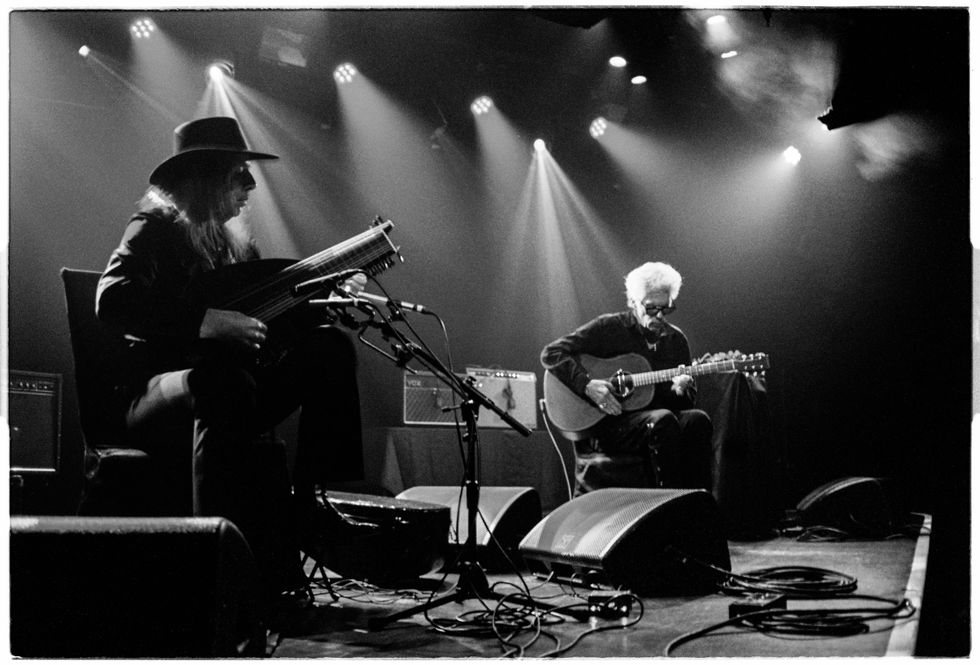
About Jarmusch’s romance with guitars, van Wissem says, “I guess it was sort of an accident that the guitar and music became a bigger and bigger focus for Jim, but I always had the idea that he really wanted to be a musician, in a way. He has definitely become a good guitarist now, having developed his own sound and approach over the years. He loves his pedals and playing wild electric stuff and feedback, but he likes playing acoustic, too. We can go from darkly beautiful, even elegant things to some pretty metal sounds, especially at the climax of these recent shows when I trade the amplified lute for a 12-string guitar, my Gretsch Electromatic.”
“David Lynch said that movies are the closest thing that humans make to dreams, and it’s true. A film is like a dream that you’re pulled into. But music is more like a kind of magic, even just listening to it. You supply your own imagination, your own feelings and associations.”
Jarmusch and van Wissem hit it off after meeting on the street in SoHo about 20 years ago. “We immediately discovered that we shared an enthusiasm for many of the same films and books, and music from Morton Feldman to Joy Division,” van Wissem recalls. “Jim is a cultural sponge—he takes everything in.” The two developed a synergistic association, performing around New York with their unique combination of instruments and making records often colored by van Wissem’s arcane, neo-gothic mythos. The lutenist, playing models made for him by Canadian luthier Michael Schreiner after Renaissance and Baroque examples, had already been recording his own minimalist, contemplative compositions solo, having eschewed a traditional route of playing the complex classical repertoire (despite a love for such Baroque lutenist-composers as Sylvius Leopold Weiss). The aim, van Wissem says, was to “dust off” the lute by putting its intimate tones in a new context, “to make it live in the now.” It was a path more in keeping with his punk-rock spirit, something the indie-minded Jarmusch could appreciate.
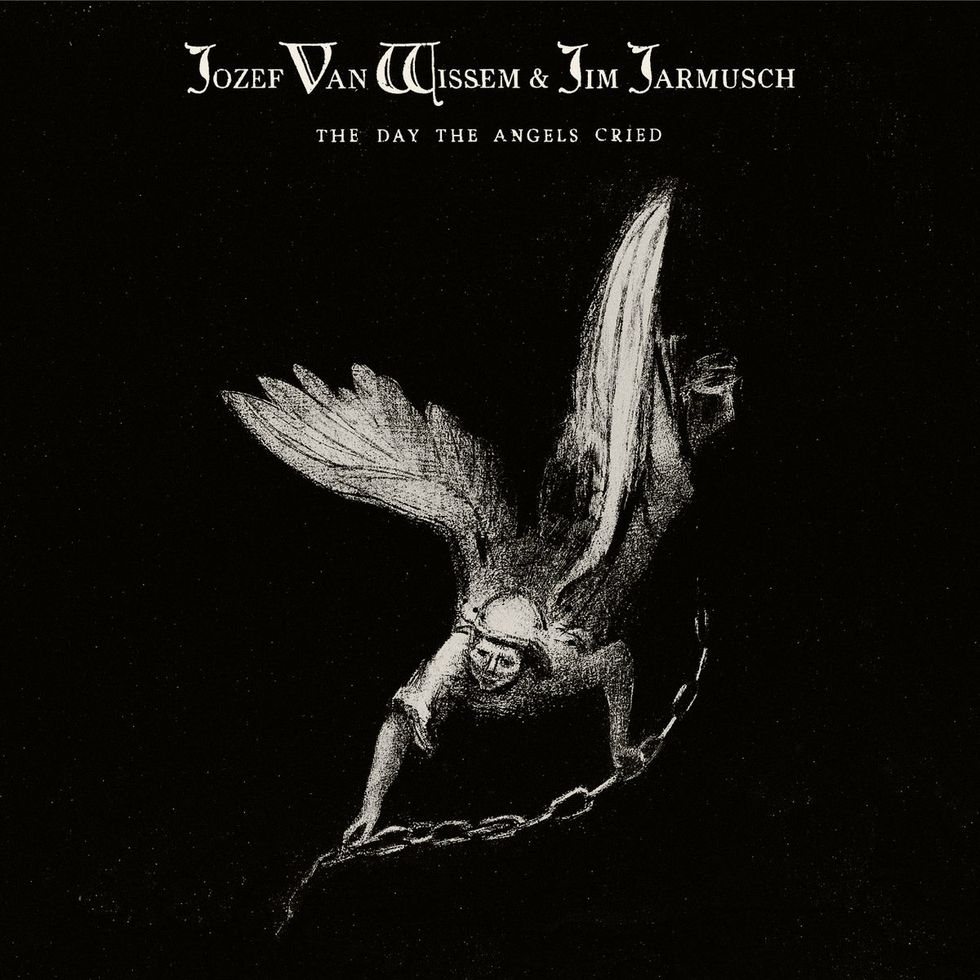
A milestone for the Jarmusch/van Wissem partnership came with the soundtrack for Only Lovers Left Alive (2013), the director’s most potent latter-day film. Although ostensibly a vampire movie, on a deeper level it’s about valuing the gifts of the past while also appreciating new possibilities ahead, despite the melancholy evanescence of this world. The score is a mosaic of Sqürl and van Wissem, with the lutenist composing the main themes—which earned him the soundtrack award at the Cannes Film Festival. It’s also the duo’s “hit,” the one crowds cheer from the first notes.
Reflecting on his various collaborations, Jarmusch says: “Making a film is a complex process with a lot of equal talents all pulling together, yet I’m necessarily the captain of the ship, navigating an idea from my imagination onto the screen. But when I’m making music with other people, I’m in a conversation. With Sqürl, I can lead things, or not. But in the duo with Jozef, he generally makes the decisions on structure, etc., which I’m then free to react to. I like that. Giving up control is good for me, and he has experience making his own records. He has always encouraged my musicality, and I trust him. Our interest in history and our sense of aesthetics align in many ways, even if our philosophies differ in some areas. I see Jozef as this Swedenborgian mystic in a way, whereas I’m a natural-phenomenological psychedelic atheist, I guess.”
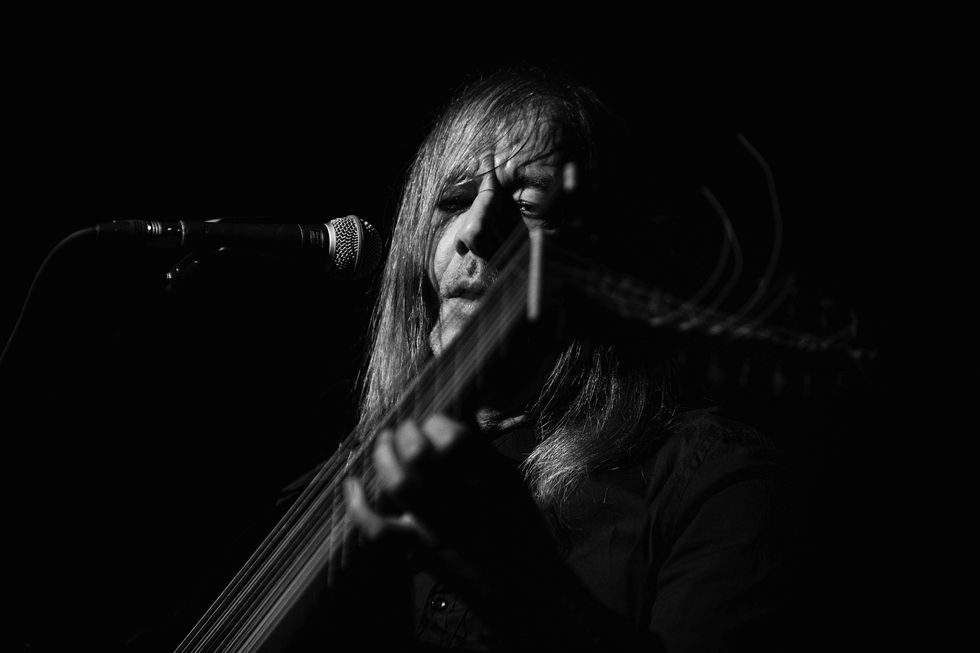
Jarmusch and Van Wissem certainly share an appreciation for the timeless power of the drone. The pick of their albums, American Landscapes, comprises three droning tone poems created in 2022 to reflect the embattled state of the nation, like an alarm-cum-lament, with the lute tolling as the guitar growls at the moon. But all of the duo’s music-making taps into a hypnotic essence. “I’ll be playing one chord, arpeggiated, for a long time, circling around, and that repetition can put a listener into something like a trance,” Van Wissem explains. “On the lute, I’m playing Renaissance drones, essentially, alternating the bass line on two strings and improvising a melody on top, the drone staying the same with some variation in the melody. It’s basic, but that trance effect at a show means you go more inward. You let things go in the process, your daily disturbances, and when it’s over, you’re different somehow. I have the same experience when I go to a Sunn O))) concert.”
Due out this fall is Jarmusch’s first movie since 2019, Father, Mother, Sister, Brother, starring Charlotte Rampling, Cate Blanchett, Adam Driver, and Tom Waits. Jarmusch tells a story involving Waits that helps illustrate a difference for him between directing movies and making music: “Once, I was with Tom at his house, and he’s sitting at this old piano and writes a song as I’m sitting there. It just comes and then goes into the ether, like perfume. At the time, I had been working on a film for two fucking years, with longer to go, and he conjured up this wonderful piece of art in the moment. Making films doesn’t have that immediacy. David Lynch said that movies are the closest thing that humans make to dreams, and it’s true. A film is like a dream that you’re pulled into. But music is more like a kind of magic, even just listening to it. You supply your own imagination, your own feelings and associations. Filmmaking is something that I love to do and hope to keep doing. But music is in another realm. I think it’s the most beautiful thing that humans do.”
YouTube It
Here’s a flashback to Jarmusch and van Wissem earlier in their union, creating droning magic in Barcelona in 2013.
MOOER Expands Its Multi-Effects Range with the GE150 Max and GE150 Plus
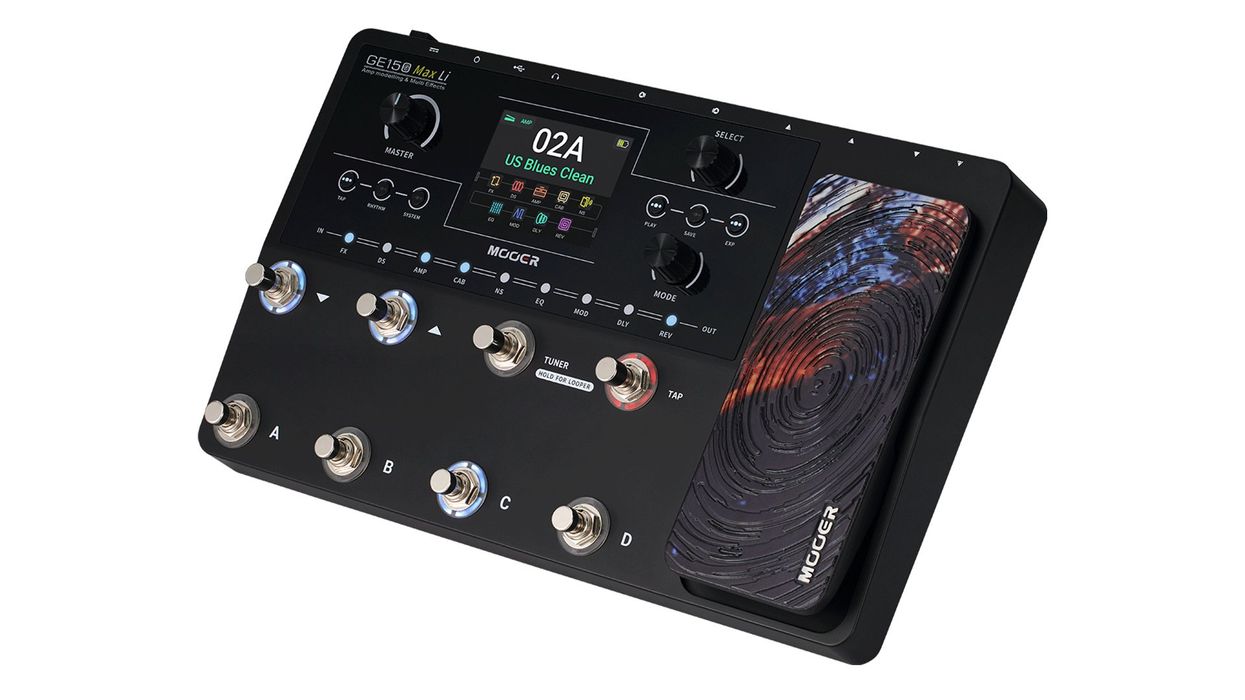
Since its initial release in 2019, MOOER’s critically acclaimed GE150 has seen several significant improvements, including through the GE150 Pro and the more recently announced GE150 Plus. However, the latest addition to the series, the GE150 Max, includes some of the most impactful additions to the series so far, all while staying true to the device’s existing functionality.
For existing GE150 users, the first thing they will notice is that, rather than having just two multi-functioning footswitches as with the original, the GE150 Max includes 8. Four of these footswitches are dedicated to switching between the four presets of each bank, whereas a further two are used to switch between banks. This is in contrast to other MOOER multi-effects pedals, where pressing two preset switches would typically shift the banks, with the new system making bank changes more accessible during a performance.
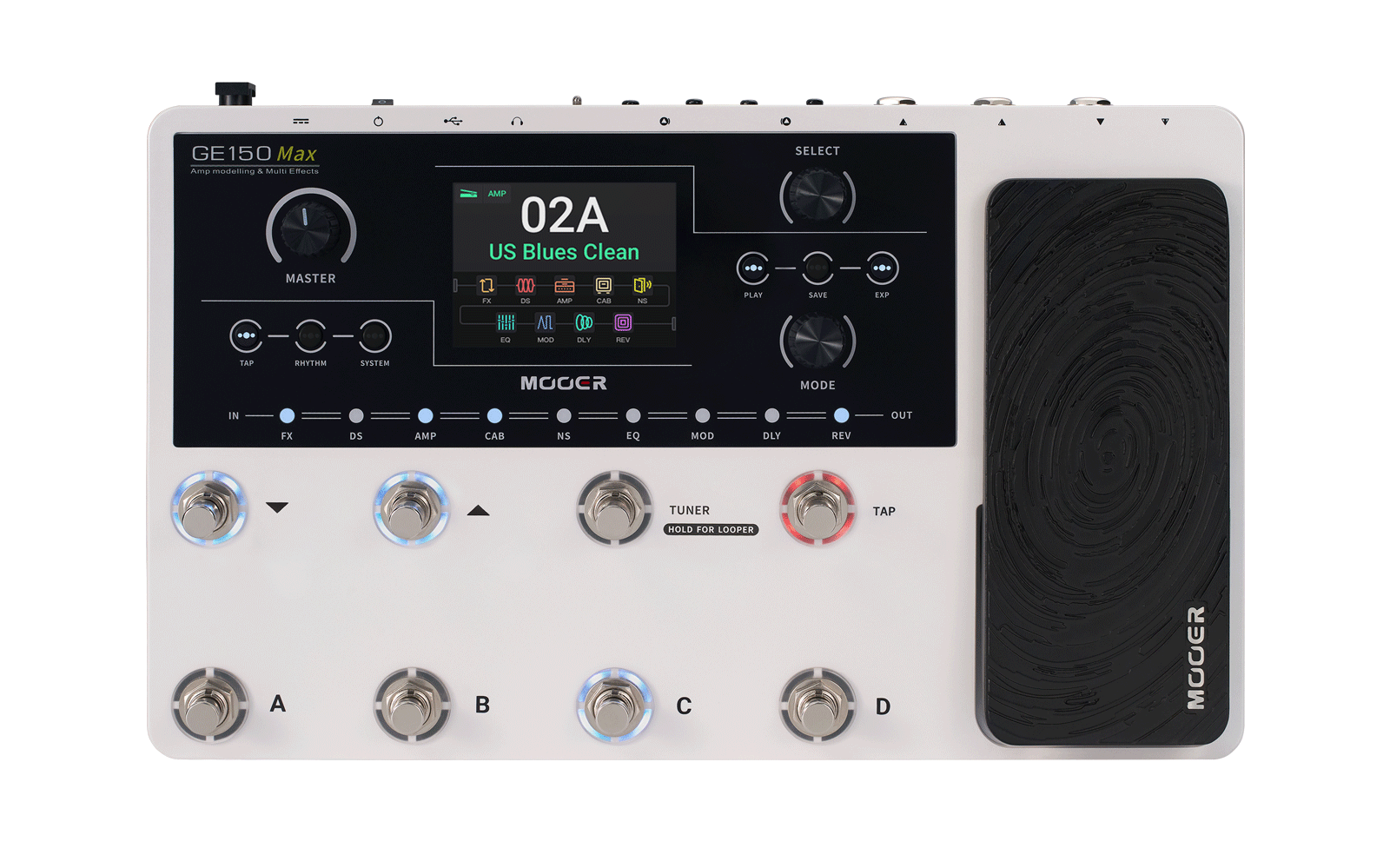
The remaining two footswitches are used to activate the tuner function, the 80-second looper system, and to determine the universal tap tempo. Despite these control mechanism changes, the GE150 Max has retained its predecessor's range of preloaded tones and effects. 50 preset banks are provided, each with 4 presets, totalling 200 customizable slots.
Many different models of delay, reverb, and modulation effects can be applied to these slots, but most importantly, the device comes with 55 preamp models, each of which is based on nonlinear modeling technology, helping to produce realistic emulations of classic amplifier tones. However, users are not limited to these tones, as the GE150 Max also supports MOOER's MNRS amp sampling system, in addition to third-party IR files for cabinet emulations, allowing users to greatly expand the device's tones through uploading their own.
To visualize the tones and effects that are currently loaded, the device is fitted with a 3.5" LCD color display, providing real-time visual feedback on the effect chain and each module's parameters. To edit these, the "Select" and "Mode" dials can be used, enabling guitarists to quickly create their own effects chains and then save them. Interestingly, the effect chains also support MOOER's new CTRL function, which enables users to map single effect modules to footswitches, facilitating more granular real-time control over the chain.

As with the original GE150, the Max edition sports an integrated expression pedal that can be mapped to tone and effect parameters, as well as output volume, adding yet another control mechanism for live expression. Interestingly, though, the Max has been augmented by the new "SPILL-OVER" function. Essentially, this ensures that delay and reverb effect tails will fade out naturally when switching presets, making smoother and more natural transitions possible in a live setting.
In terms of the internal drum machine and looper, MOOER has stuck to the successful formula of the original GE150. 80 seconds of looping time allow for creative improvisations and loop-based compositions, and a 40-style drum machine is also provided, complete with 10 metronomes. The previously mentioned "Tap" footswitch can be used to accurately determine the BPM of these features in real-time.
Aside from the GE150 Max's internal features, it also boasts an impressive upgrade on its audio output options. Most notably, in addition to the expected 1/4" stereo outputs, it is also fitted with a stereo balanced XLR output. Guitarists can choose this output option to shield their output from signal degradation and distortion over long-distance cables, guaranteeing a cleaner, more stable, and generally more professional live output than was previously possible.
As if this weren't enough, an Aux In port is also provided for connecting to smartphones or external audio players, allowing guitarists to jam along to their favorite backing tracks or rehearse their band's material. The device's USB port can even be used for OTG recording into a mobile device, as well as for the management of presets, sample files, and firmware through a PC. Combining this versatile selection of audio routing options with the GE150 Max’s upgraded functionality, guitarists truly have everything they need for professional-grade live performance, all within a light-weight and compact package.
Product Features
- 8 multi-purpose footswitches
- 3.5" LCD color display
- 200 preset slots across 50 banks of 4 presets
- 55 preamp models, made possible through intelligent nonlinear sample technology
- Amplifier and cabinet modules support MNRS sampling files
- Cabinet simulations support third-party IRs
- Parameter-mappable expression pedal
- CTRL function, allowing footswitches to be mapped to toggle individual modules within an effect chain preset
- Tap-tempo footswitch
- “Spill-over” functionality for smooth reverb and delay transitions during preset switches
- Built-in 80-second stereo looper
- Integrated drum machine with 40 drum patterns and 10 metronome modes
- Mono ¼” inputs and outputs
- XLR balanced output, ideal for the prevention of signal degradation over long-distance live audio routing
- Aux input port for external audio playback
- USB-C port for tone editing, recording, firmware updates, and mobile device connectivity (via OTG)
The GE150 Max will be available from the official distributors and retailers worldwide on 10th September 2025.
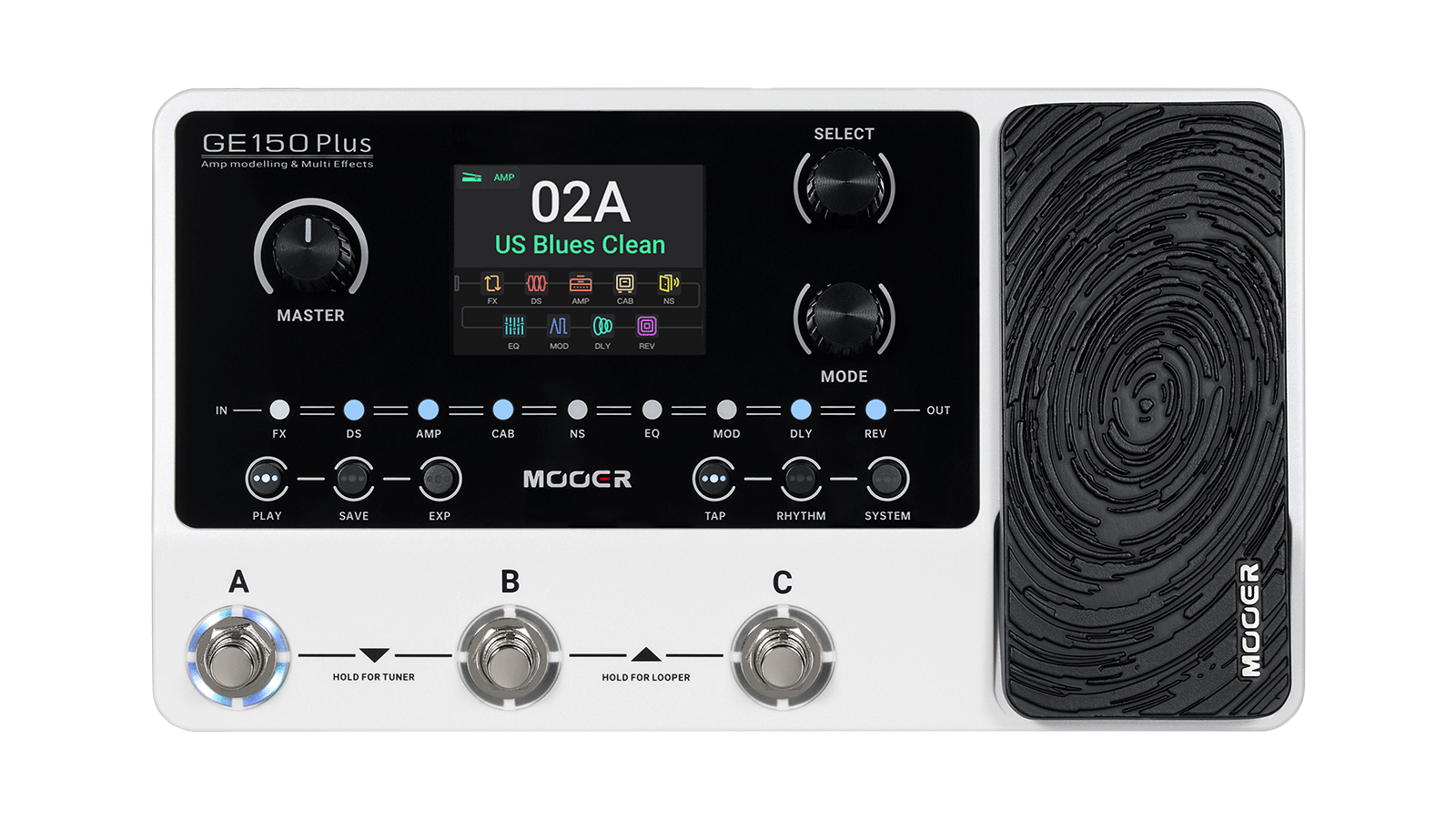
Following the success of the original GE150 pedal, MOOER is excited to introduce the new GE150 Plus, a new multi-effects and amp-modelling pedal. The device has been upgraded to offer guitarists advanced functionality, greater performance flexibility, and enhanced sonic quality through the new GE series design language and user interface.
First and foremost, the GE150 Plus provides memory for up to 198 preset patches, giving users a comprehensive range of tonal possibilities for various musical styles. Presets can be crafted through effects such as reverb, modulation, and dynamic enhancements, and most importantly, 55 precise preamp models developed using MOOER’s intelligent nonlinear sample technology. This enables the pedal to accurately reproduce the unique tonal characteristics and dynamic response of classic amplifiers, further enhanced by the device’s amplifier and cabinet modules. Both amps and cabs allow for loading MOOER’s MNRS sampling files, while the cabinet simulations also support third-party impulse response (IR), further expanding the device’s flexibility.
Another particularly impressive new feature of the GE150 Plus is the “spill-over” function, which enables delay and reverb effects to fade naturally when switching between presets–a feature that was missing from the original GE150. Ultimately, this ensures smooth, uninterrupted performance when making sonic changes during live performances.

As with past editions of the GE150, the pedal includes a convenient and intuitively designed 80-second stereo looper. This can be used in combination with the GE150 Plus’ groove station, which includes 40 integrated drum patterns alongside 10 metronome modes. All of these features are controlled effortlessly through three multi-purpose footswitches, bringing all manner of creative purposes for both live looping and rhythmic practice. An expression pedal is also built into the device, giving guitarists further dynamic control over parameters in their effects chain.
Compared to the original GE150, the GE150 Plus has USB connectivity that is significantly enhanced. Through USB-C, the pedal can be easily integrated with MOOER’s PC software for preset editing, as well as for data management, firmware updates, and mobile device audio recording through an OTG cable. An aux input port further expands practice possibilities by enabling external audio sources like smartphones, software, or other hardware to be used as a backing track.
Following MOOER’s recent trend of producing fully portable products for musicians on the move, the GE150 Plus is available in two distinct editions, one of which is battery-powered. The standard model offers reliable mains-powered operation, while the GE150 Plus Li version also incorporates an integrated lithium battery, providing approximately 9 hours of continuous use. Additionally, the GE150 Plus Li comes with an exclusive black finish. Overall, the GE150 Plus continues MOOER’s commitment to delivering powerful, versatile, and travel-friendly solutions, making it an essential upgrade within the critically acclaimed GE series.
Product Features
- Up to 198 preset patches
- 55 preamp models, made possible through intelligent nonlinear sample technology
- Amplifier and cabinet modules support MNRS sampling files
- Cabinet simulations support third-party IRs
- Three multi-purpose footswitches
- Parameter-mappable expression pedal
- “Spill-over” functionality for smooth transitions between effect tails
- Built-in 80-second stereo looper
- Integrated drum machine with 40 drum patterns and 10 metronome modes
- USB-C port for tone editing, recording, firmware updates, and mobile device connectivity (via OTG)
- Aux input port for external audio playback
- Compact, lightweight, and travel-friendly design
- Available in standard (white) and lithium battery-powered Li version (black)
Oh, No! My Amp Is Making Noise!
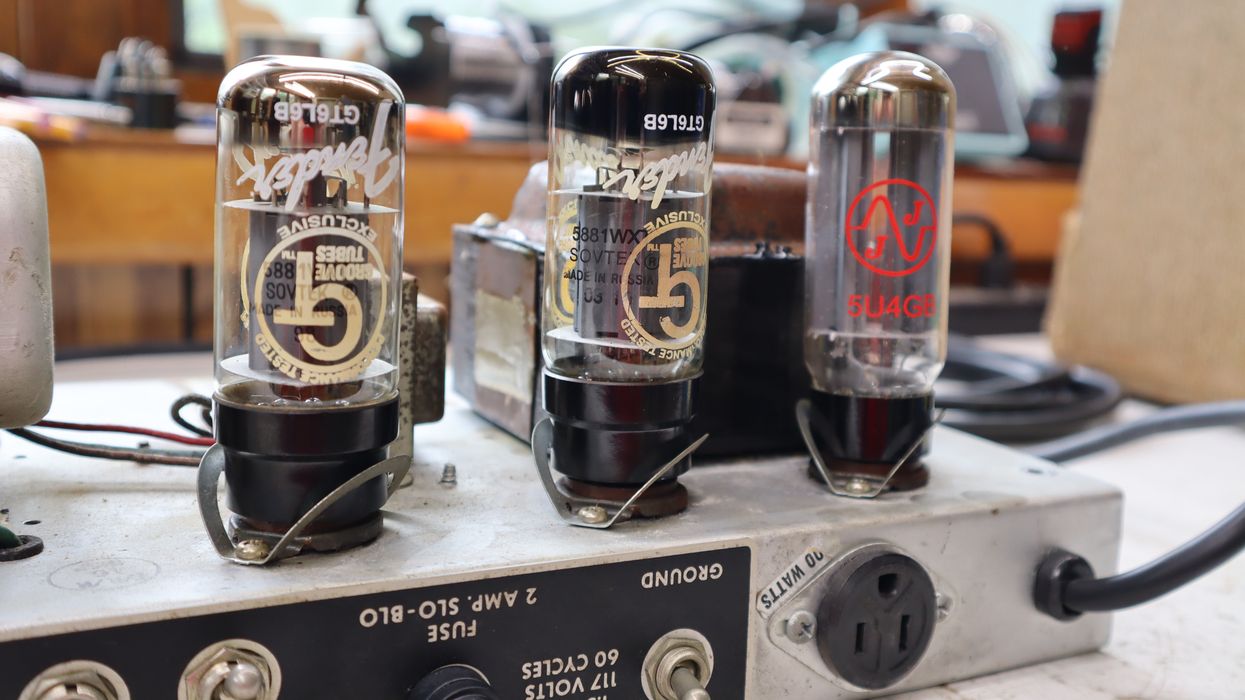
If you’ve owned a tube amp for pretty much any amount of time, you’ve been there: Your amp starts making noise—probably at the worst possible moment, whether onstage, in the studio, at rehearsal, or when you just really want to play—and you don’t know what to do. Maybe you keep it cool, but maybe you panic: Is my amp broken for good? Is this going to cost me hundreds of dollars? Fortunately, there are a few basic things you can check before you call your amp tech in a frenzy.
Ultimately, an all-tube guitar amp is actually a very durable device. But it’s important to remember that these amps need maintenance and have parts that are going to need to be replaced over the course of their lives—and tubes are the most likely place to check when you’re having a problem.
Many vacuum tubes are “military grade,” which means they can withstand shock, vibration, humidity, temperature, and many other harsh conditions. That doesn’t mean they are fail-proof, though. So, when your amp is making noise, here are some ways to check out your tubes.
Look
Do a visual inspection. Are your amp’s tubes bright and shiny, or do they look weathered and dirty? If they look old, they may be old. This doesn’t have to be a sign of something wrong, but tubes wear out like lightbulbs—they work until they don’t. I usually say power tubes have a two- to five-year lifespan (for professionals, it’s more like six months to two years). Preamp tubes have more like a five- to 20-year life. They can function longer but start to get problematic before they just die.
Look at what’s going on inside. Is the clear part of the glass still clear? If there is a smoky look on the inside of the glass, that is a sign of heavy wear. Look at the shiny mirror-looking part; that is the getter flashing. It should look bright, though sometimes there is a little fuzziness along the edges. If it is getting smoky, then the tube is tired. And if it has gone completely white, the tube is toast.
The last visual is best done in darkness. Look for the heater element inside. It is a wire in the very center of the tube structure that glows red when operating. Don’t worry about what shape it is, how much you can see it, or if it looks exactly like the other tubes. If it is glowing, it’s good; if it is dark in there, it’s toast.

Listen
Let’s move on to audible diagnostics. The amp works but is making extraneous noises. The first thing to do is unplug the guitar cable from the input of the amp, so nothing is plugged in, the amp is fully on, and the tone controls, volume, and master (if applicable) are full on. What noises do you hear? If it is silent with a tiny little bit of background noise, that is as good as a guitar amp gets.
Are you hearing an electronic, almost morse-code sound? A common modern problem is RF (radio frequency) noise from routers, cell phones, and transmission towers. It is not the amp and there is nothing to fix, but if you try moving the amp around the room or building, you may find a quieter place.
Is the amp making a constant “shhhhh” sound? Does it get louder if you turn the volume knob up? That is thermionic emission, the noise of electrons flowing. It is a byproduct of gain. Low-gain amps have less, and high-gain amps suffer greatly. Some tubes can add to this, so if you replace the first couple tubes in the signal path and it helps drop the noise floor, then keep the noisy ones for less critical positions.
Is the amp sitting there doing the snap-crackle-and-pop thing? This can be a tube issue, but most of the time it is a component issue inside. If you have a known good tube, you can replace the tubes one at a time, seeing if the noise changes. If you find that it was a tube, that tube is toast, so don’t use it as a spare.
Now, let’s talk about microphonics. Because of the amount of gain we have in guitar amps, microphonic tubes can be problematic. Start turning the amp volume/gain all the way up. If you get a howl, like with an open microphone, you have a microphonic tube. If it is still behaving but you can tap on the amp and get a sound like tapping on a microphone, that can be acceptable.
Finding the Cause
There are multiple tubes in an amp, so let’s find the root of the noise. The first thing is tap testing. The best tool is a pencil with an eraser. One by one, tap on the tubes with the amp on and turned up. If you get a significant microphonic sound from one, it should be swapped out with a quieter one. Now, this is the thing: A little bit of microphonics is normal, so it will take a little getting to know your amp to learn what is acceptable or not. Certain brands/models of tubes are better than others, so just because it’s new doesn’t mean it’s better or even good. As you go down the line of the signal chain, the gain is less, so you are looking for slight noises. Once you get to the power tubes, they can be microphonic, but they don’t howl like a preamp tube. They make a thud sound when tapped.
The other thing we’re looking for with this tap testing is rattling. Again, there is a certain level of acceptable rattle. But if you can hear it through the speaker, that’s unacceptable. If you have power tubes that rattle, this sometimes does not come through the speaker, but you can hear it when playing the amp at lower levels. If that bothers you, then they need to be replaced even though they’re functioning properly.
The last diagnostic is pulling the preamp tubes (not the power or rectifier tubes). Starting with the first tubes in the signal chain, pull them out one at a time and listen to see if the noise goes away. If you pull a tube and the noise disappears, then either that tube is the culprit, or your problem lies in that part of the circuit.
If you’re looking for a quick fix to get you through your gig or session and you narrow your problem down to a tube, go ahead and swap it out. If your amp is fixed bias, you may still need to head to your tech tomorrow and have it biased, but you’ll get your work done today. And when in doubt, replace your old tubes. If it turns out that wasn't the issue, you now have good spares for when a tube does eventually give you problems.
A Guide to Shrapnel Shred
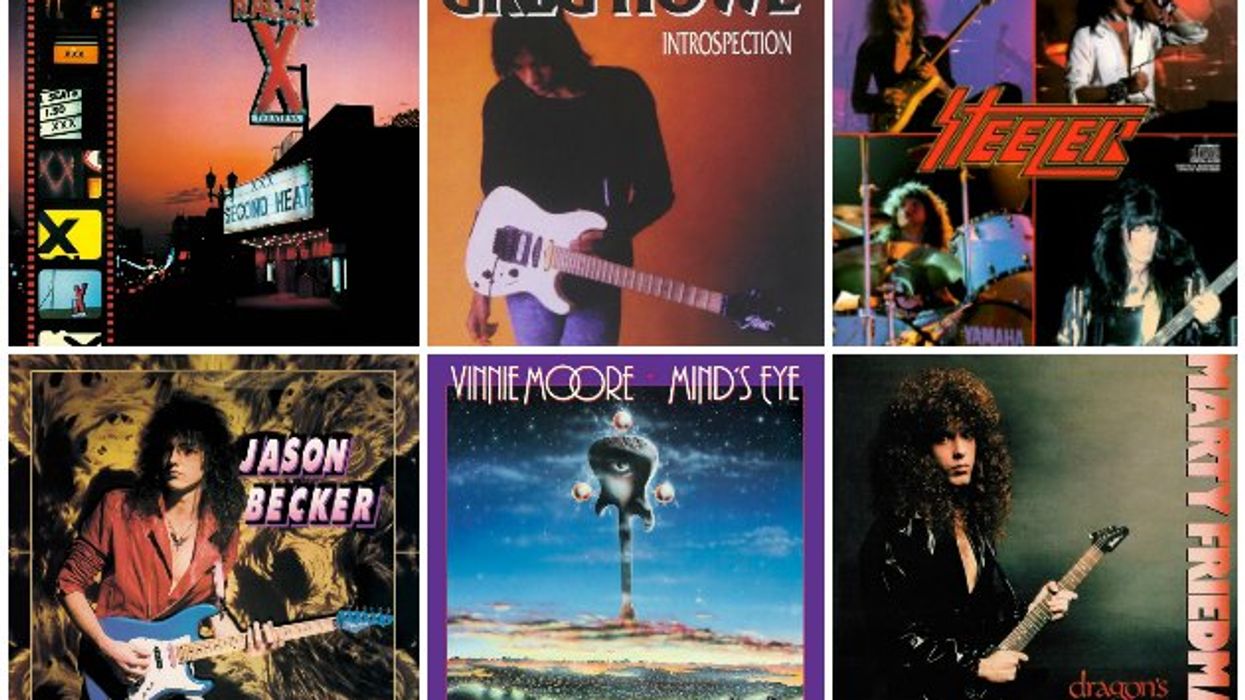
Chops: Advanced
Theory: Intermediate
Lesson Overview:
• Work through sweep arpeggios in the style of Jason Becker.
• Add more chromatic notes to your improvised solos.
• Make your riffs more compelling with unexpected rhythmic subdivisions.
Click here to download a printable PDF of this lesson's notation.
Shrapnel Records introduced the world to some of the most virtuosic rock and metal guitarists to have ever plugged into a high-gain amp. Starting in the ’80s, an era that has subsequently become infamous for guitar gods, Shrapnel’s founder Mike Varney carefully selected the cream-of-the-crop players for his unique record label.
Some Shrapnel alumni are best known for sweep picking, others for insane alternate picking, and yet others for emphasizing legato fretwork. But all of them are known for playing a lot of notes in a very musical way. What made many of these players great, in my opinion, is that each took a unique approach to playing and writing within the fairly specific “shred” genre.
Want to acquire some tricks of their trade? Let’s take a look at key ideas and techniques used by several of Shrapnel’s heaviest hitters.
Most people associate Shrapnel guitarists with technical lead playing, but before we go there let’s first visit the often-overlooked art of playing rhythm. In my opinion, Paul Gilbert and Bruce Bouillet of Racer X were absolute masters of creating rhythmically exciting and unexpected metal riffs. These were often based on strong rhythmic hooks that included subdivisions and interwoven exchanges, and took surprising aural twists and turns.
Ex. 1 is a Racer X-style riff in A minor that illustrates the basic idea of taking one rhythmic pattern and throwing in surprise subdivisions. This riff’s main rhythmic pattern is based on three-note groupings of 16th-notes. In the first measure we encounter a new subdivision on beat 4. Hear how those 32nd-notes surprise the ear? It’s a great example of what Racer X was known for.
Another example of this effect is in the riff’s second fill. We have a 16th-note triplet run to wrap up the first repetition (starting on the “and” of beat 3 in measure 2), and again, the change in subdivision from the main 16th-note pattern creates an additional rhythmic twist.
Click here for Ex. 1
Now that we’ve had a dose of rhythmic content, let’s shift over to the kind of lead playing that makes many listeners’ jaws drop. Because he introduced pop and R&B-inspired chord changes and funky rhythms to what was fundamentally a hard rock and metal label, Greg Howe is arguably one of the most distinctive Shrapnel artists. To make things even more interesting, he favored an innovative tapping technique and infused his playing with chromatics.
Inspired by the record Introspection, Ex. 2 is a Greg Howe-style lick over a series of dominant 7 chords. Hear how the chromatics are interwoven between E7 and B7 chord tones on the weak parts of the beat? This is a common jazz guitar technique, but it’s made very Howe-ish thanks to Greg’s grooves, feel, and note choices.
Next over A7 comes one of Greg’s most famous tapping techniques. This line also demonstrates his “hammer-on from nowhere” technique, which means that the hammer-on note isn’t approached by a previously picked note. Finally, we have another of Greg’s famous tapping techniques over the F#7. Here, we take three-note-per-string scales and instead of picking every note or playing full-on legato, use a hammer-hammer-tap pattern to cover the ascending phrase.
Click here for Ex. 2
Another Shrapnel powerhouse is Tony MacAlpine, who is famously known for his blazing picking and his blend of classically inspired themes and contemporary instrumental music. Ex. 3 pays tribute to his approach to arpeggios.
The opening phrase is one of my favorite Tony-isms. We’re creating a major 7 arpeggio, in this case Dmaj7, by only using the lowest two strings. Keep in mind that there’s absolutely no picking here—it’s strictly legato and tapping. But the real interesting thing about this kind of line is the context in which Tony often uses it. Here, we’re in a Bm tonality, so we can use a D major arpeggio (Bm’s relative major) and still stay in the key.
Click here for Ex. 3
We’ve explored a variety of tapping and arpeggio ideas, but haven’t yet encountered one of the most common staples of the Shrapnel guys: alternate picking licks! Many of the Shrapnel guitarists are well known for playing long, scalar runs in which they pick each note. If used wisely, this can be one of the simplest ways to enhance your playing, as these runs are mostly pattern-based and primarily built on the three-note-per-string scale fingerings.
A simple alternate-picked line in B minor, Ex. 4 starts with a six-note scale shape that’s copied across three octaves. You’ll find this fragment (the first three beats of the first measure) on many Shrapnel albums. Keep in mind that strict alternate picking is crucial for the accuracy and cleanliness of a lick like this, so be sure to practice it slowly.
Because these lines work so well in the three-note-per-string fingerings, they’re often conducive to some sort of triplet subdivision. The kicker with such licks is that they’re very pattern-based and can end up sounding too much like an exercise. Use them wisely and musically.
Click here for Ex. 4
And last but not least, what would a column on Shrapnel be without a mention of the legendary Jason Becker? For dedicated shredders, his playing and spirit need no introduction, but if you need one, check out this trailer for the excellent documentary Not Dead Yet.
Ex. 5 is a workout in Becker-style sweep arpeggios. One point that was unique about Jason’s particular approach to sweep picking is that he extended certain arpeggio shapes further than other players did. In this example, all of the shapes extend down to include two notes on the 5th string. It’s fairly rare to see the Bm and E shapes extend down that far, but that’s part of Jason’s nuanced magic. The key to successfully playing sweep arpeggios lies in the picking pattern. It’s always a specific, non open-ended pattern that isn’t as simple as just constant downstrokes and upstrokes. A hammer-on or pull-off is included every time there’s two notes played on the same string.
Click here for Ex. 5
Keep in mind that playing anything cleanly and accurately lies in practicing very slowly, in time with a metronome. These guys were all masters of fast playing, but I believe they were standouts because they used their chops in clever and musical ways, and that composition was their first priority. So when you’re sitting down with your metronome to blaze through these licks, just remember that music comes ahead of technique.
Racer X
This blazing live performance of Racer X’s “Scarified” from 1988 illustrates how Paul Gilbert and Bruce Bouillet varied the rhythms within their warp-speed riffs.
Greg Howe
Greg Howe improvises an incredible solo over his tune “Come and Get It.” Check out 0:45-0:48 for a great example of one of his signature tapping techniques.
Tony MacAlpine
Here’s Tony MacAlpine playing “Pyrokinesis” with an excellent view of his fretboard. Marco Minnemann plays the drums on this track and MacAlpine plays everything else. Look for his tapped arpeggios sequences and notice how he weaves them into both the melody and the solo.
Jason Becker
The legendary Jason Becker performs a dazzling mix of feisty, extended-range arpeggios in this clip from a guitar clinic in 1989.
Kiesel Unveils Kyber Headless and Masvidalien MIII Models
Kiesel Guitars has introduced the two newest models in the company’s iconic line of custom-built instruments: the Kyber Headless and Masvidalien MIII now join the lineup of Kiesel’s premium US-made instruments.
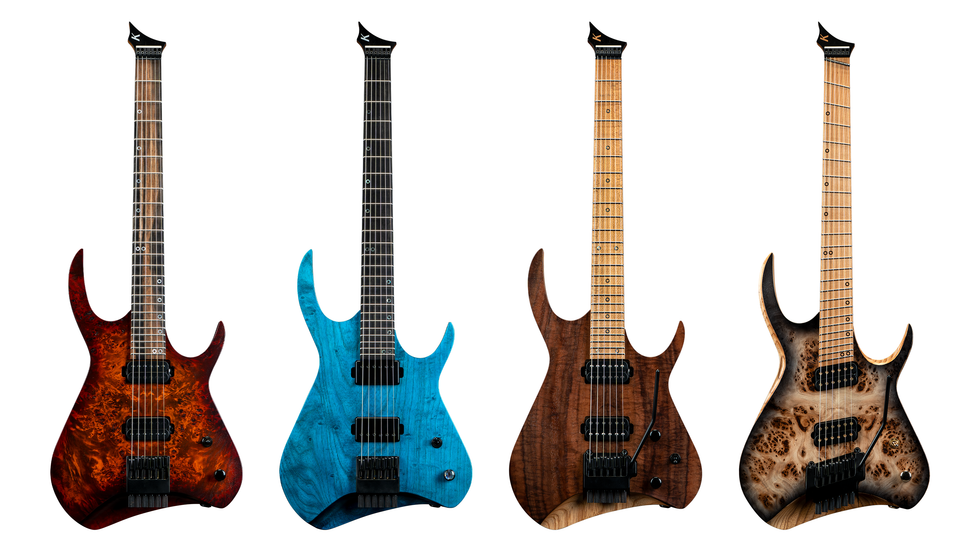
Designed to excel in a variety of musical styles, the versatile Kyber Headless is available in 6, 7, and 8-string configurations, standard or multiscale. Key features include:
- 7 different body woods for customization
- 25.5” scale length, 15 different fretboard woods for customization, 24 frets
- Over 100 different pickup configurations
- Kiesel-Designed locking nut, headpiece for hanging, optional body scoops
The Masvidalien MIII is the debut Kiesel signature model from Paul Masvidal, guitarist and composer known for his work with Cynic, Death, Æon Spoke, and Mythical Human Vessel.
Built in Kiesel's California factory, the MIII was designed with strength, resonance, and playability at its core. Inspired by Kiesel's Kyber model, which Masvidal was already connected to, the MIII began as a natural extension of that instrument but quickly evolved into something uniquely its own, a hybrid guitar that expands on the Kyber's spirit and opens new creative ground.
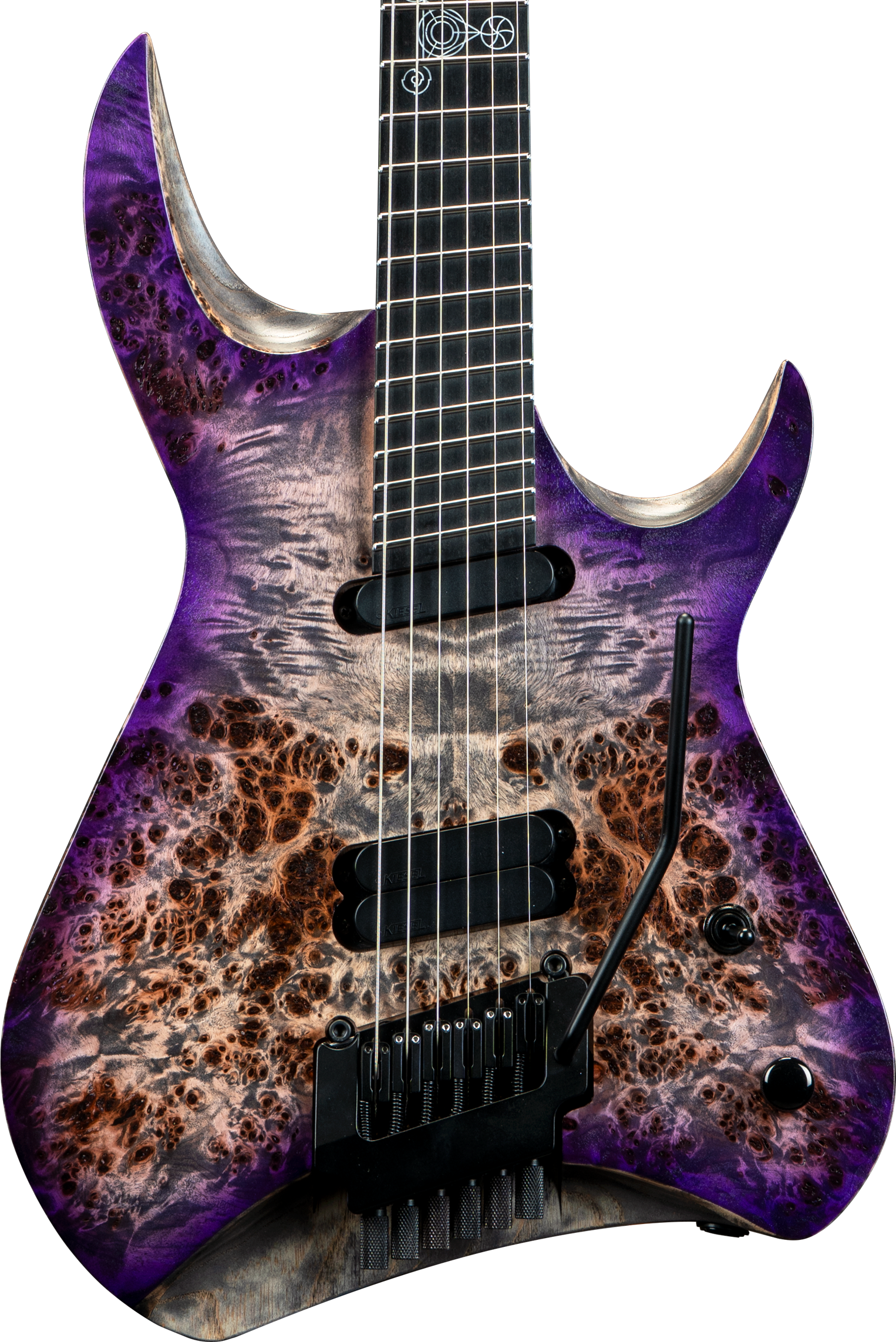
Key features include:
- Woods: 5A Poplar top with a Swamp Ash body, Buckeye top with a Roasted Swamp Ash body
- 25.5”-26.5”, Fretboard woods: Ebony, Richlite Diamond, Roasted Maple, Royal Ebony, and Roasted Birdseye Maple, 24 Fret
- The brand-new Focus pickup, a humbucker made from two blade-style single coils that offers tighter and more precise tones
- The Hybrid carbon fiber/wood neck, the Barbury Castle Crop Circle inlay, Headpiece for hanging,
Like other Kiesel models, the new Kyber Headless and Masvidalien MIII are available in a wide range of options for unique customization. Players can select their favorite finish, tonewoods, electronics and hardware to create the guitar of their dreams…expertly crafted in Kiesel’s Southern California custom shop.
Kiesel’s new Kyber Headless is available for street pricing starting at $1,599. The new Masvidalien MIII is available for street pricing starting at $3,199. For more information visit kieselguitars.com.
Steve Morse Band Announces Brand-New Studio Album
The Steve Morse Band has announced details of their brand-new album, Triangulation, which will be released on November 14 via Music Theories Recordings (Yngwie Malmsteen, Ayreon, Paul Gilbert, Vandenberg). To celebrate, they have unveiled the official video for their new track, “Break Through.”
“Break Through” is the first new music since the release of 2009's Out Standing In Their Field. Talking about the track, Steve Morse shares, "This may start with a guitar riff, but the bass carries the melody. It's just a great feel to play over, and a positive vibe to start the album."
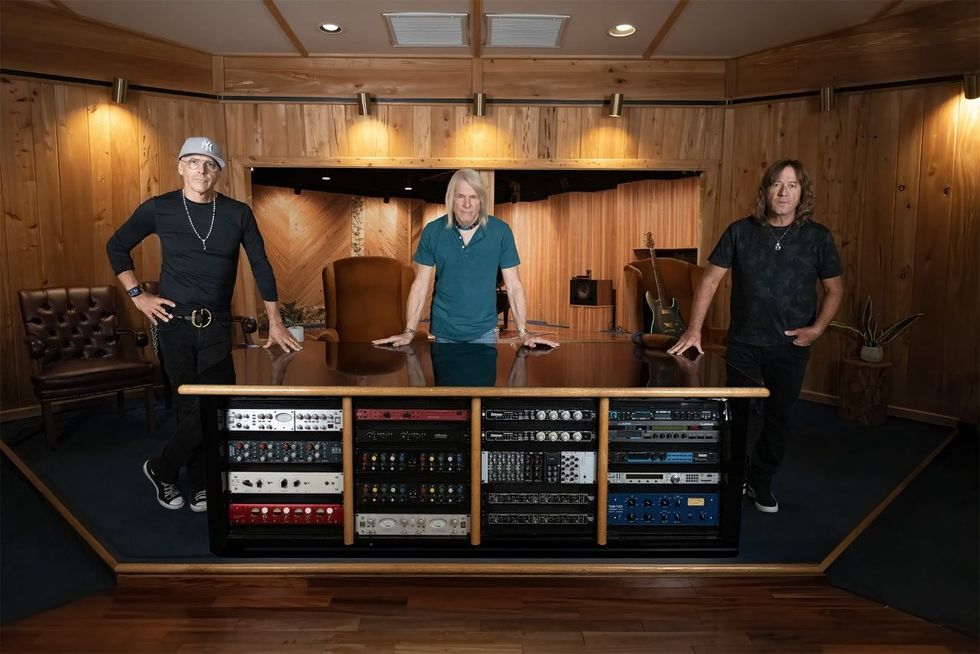
Whenever we think of the greatest guitar players of all time, Steve Morse is a name that's always in the conversation. This album sees Morse teaming up once again with Dixie Dregs, Steve Morse Band, and Flying Colors bassist Dave LaRue, with Van Romaine [Steve Morse Band/Enrique Iglesias] joining on drums.
Steve beams, "Dave and Van have been the bedrock of this trio, and this recording shows why. These guys are unique and incredible musicians on their own, and together, our chemistry is magical. While making the album, we played together, working through parts, riffing off each other, and collaborating on arrangements. I'd bring an idea, and hear it instantly — and then hear it improved. We made this album together, and you can hear it."
There are also some stellar guest features, from Eric Johnson's majestic contributions to “TexUS” and John Petrucci bringing his inimitable progressive metal thunder and, of course, Kevin Morse joining his father on "Taken by an Angel.".
Executive producer Bill Evans noted, “The compositions are among Steve’s best. And audiences can finally hear every detail of Van and Dave’s performance…the band’s collaborative musicality.” Steve added, “Brian captured me brilliantly, and Carl Roa created more sonic and performance clarity than we’ve ever had.”
Morse started his career in the mid-1970s, playing mind-melting jazz-rock with The Dixie Dregs, which earned him multiple Grammy nominations in the process. The following decade, he formed the Steve Morse Band, grabbing an additional Grammy nod, and joined arena heavyweights Kansas, before being recruited by rock and roll originals Deep Purple in 1994. And despite being in one of the world's biggest bands, he continued to innovate in other projects like Living Loud, Angelfire, and Flying Colors – as well as guitar supergroup G3 – showing the world just how much versatility there was in those magic fingers. He announced his departure from Deep Purple in 2022, choosing to care for his wife, who passed away in 2024, by that point having become their longest-serving guitarist.
Naturally, the last few years have been the most personally traumatic of his life, which is perhaps why this year's creative comeback with the new Steve Morse Band album Triangulation embodies the spirit of a master returning to do what he does best. Its nine tracks are a thrilling ride through the mind of a musician who seemingly knows no bounds, crossing over into a cornucopia of sounds and styles from funk and blues to classical and metal.
“The album title Triangulation comes from the concept of aviators, navigators, and sailors looking at two points to pinpoint their exact location at a specific moment in time,” says Steve. It's a geographical concept that also applies to human life on a broader level, and given the journey Morse has been on in recent years, it's only natural that he's been on a path of self-discovery and reflection.
Perhaps the most poignant of the nine tracks is "Taken By An Angel" – a tribute to Steve's beloved wife Janine. Steve left the music world behind to care for her, remaining by her side until her final days. "That song is new territory for me," explains Morse. "It was put together for my late wife's memorial service, with my son Kevin playing along. It brought tears to many folks' eyes because Janine was a huge part of my life and career. People knew her from the Steve Morse Band tours. She was the smiling face opening CDs for me to sign, selling t-shirts, listening to people's stories in the crowd, and taking photos for VIP visits."
After all the heartache and anguish of the last few years, you can't help but feel grateful Morse is once again ready to share his creative genius with the world around him. Given his stature among the guitar community – often lauded as 'your hero's hero' in the same way people spoke about Jeff Beck – his creative return marks a new phase of inspiration and brilliance. In that sense, you can tell the release of this record means a lot to him.
The band hits the road in October bringing the new repertoire to the stage. Steve Morse shares, “Every generation or so, we put out a new album, and the time is now! We'll be doing new material on stage, and have enlisted a special guest, Angel Vivaldi, to allow us to better perform some of the layered tunes in concert. Excited to have a bigger sound and new material! See you on tour!” Van Romaine offers, “I am so thrilled for this brand new major Steve Morse Band chapter with new tour dates and an album that was so much fun to record with Steve and Dave LaRue, and a couple special guests. While music is always subjective this Triangulation album is such a gem to me on many levels.”
Upcoming Appearances are:
- 10/09 Louisville, KY Headliner’s
- 10/10 Nashville, TN CMA Theater
- 10/12 Charleston, SC Charleston Music Hall
- 10/13 Atlanta, GA Variety Playhouse
- 10/14 Charlotte, NC The Neighborhood Theatre
- 10/15 Raleigh, NC The Rialto Theatre
- 10/16 Annapolis, MD Rams Head On Stage
- 10/18 Elkton, MD Elkton Music Hall
- 10/19 Lititz, PA Mickey’s Black Box
- 10/20 Red Bank, NJ The Vogel
- 10/21 Sellersville, PA Sellersville Theater
- 10/23 Somerville, MA Somerville Theatre
- 10/25 Cohoes, NY Cohoes Music Hall
- 10/26 Ridgefield, CT Ridgefield Playhouse
IK Releases Brown Sound 82/84
IK Multimedia releases the Brown Sound 82/84 Signature Collection for TONEX, the third and final installment of the limited TONEX Brown Sound series. This collection features 83 carefully crafted Tone Models, including several amp-only captures for use with your favorite IRs or running through a real cab on stage.
As the push for radio-ready hits grew stronger, the Brown Sound became tighter, more refined, and more polished without losing its iconic edge. Users will discover both authentic recreations and thoughtful variations to reflect different theories about how these legendary tracks were recorded.
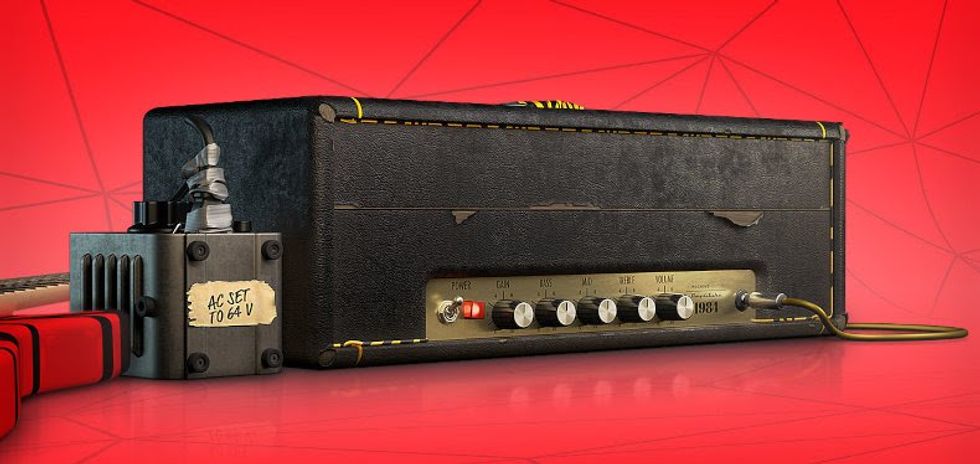
1982 Tone Models
The '82 sessions introduced a brighter, more layered tone while preserving the core character of the previous recordings. The G12-65 speaker remained key to the sound, delivering a tight low end, warm midrange, and a smoother, less spiky high end than the earlier Greenbacks. Recorded in Amigo studios, changes in mic placement and outboard gear added polish and dimension, resulting in a more refined studio sound.
1984 Tone Models
The '84 sessions marked a leap forward in tonal precision and production quality. Tracked and mixed at a newly built studio in Coldwater Canyon, the sound became more controlled and processed, yet still retained the grit and energy of earlier recordings. The suspected use of Telefunken EL34s likely contributed to the added warmth and mid-forward presence, while amp tweaks and precise Variac adjustments gave each track its own tonal identity.
The Amp: "The ONE"
At the heart of the Brown Sound 82/84 collection is "The ONE" - a meticulously crafted Marshall-style amp built from the ground up with the exact same spec as the infamous 1968 Super Lead serial number #12301, including crucial mods that capture the DNA of the early brown sound like no other amp model.
No Tone Unturned
Each Tone Model was built using controllable levers like Variac voltage, cab voicing, mic geometry, and parallel load, with options spanning different voltages, speakers, and pickups to reflect the shift from '82 to '84. All models are level-matched, offered with or without parallel load, and captured raw without post-processing for authentic, period-correct amp tones.
Ready to Play
As with all collections in the series, these Tone Models were crafted using period-correct gear and capture techniques to recreate the final two albums of that era genuinely. Each Tone Model reproduces the recorded album tone in exquisite detail, offering an ideal foundation for adding time-based effects—either within TONEX or through a favorite pedal.
Pricing and Availability
The Brown Sound 82/84 Signature Collection is now available via ToneNET and within any version of TONEX for Mac/PC at $/€99.99.*
- TONEX Brown Sound 78/79 - $/€99.99* - Includes 50 Tone Models.
- TONEX Brown Sound 80/81 - $/€99.99 - Includes 73 Tone Models.
- TONEX Brown Sound 82/84 - $/€99.99 - Includes 83 Tone Models.
- TONEX ONE Brown Sound Limited Edition - $/€249.99 - Available in white, red, or yellow. Includes Brown Sound 78/79 and a choice of one other Brown Sound collection (a $/€199.98 software value). Existing Brown Sound 78/79 users will receive a $/€50 discount at the IK store.
- TONEX Brown Sound Anthology Collector's Limited Edition - $/€599.99 - Shipping now. Box set includes all three colors of TONEX ONE (white, red, and yellow) plus all three Brown Sound Signature Collections (78/79, 80/81, and 82/84). Limited to 200 units worldwide.
*Pricing excluding taxes.
For complete details and information about the Brown Sound Anthology collections and pedals, and to hear the tones, visit:
Find Your Voice
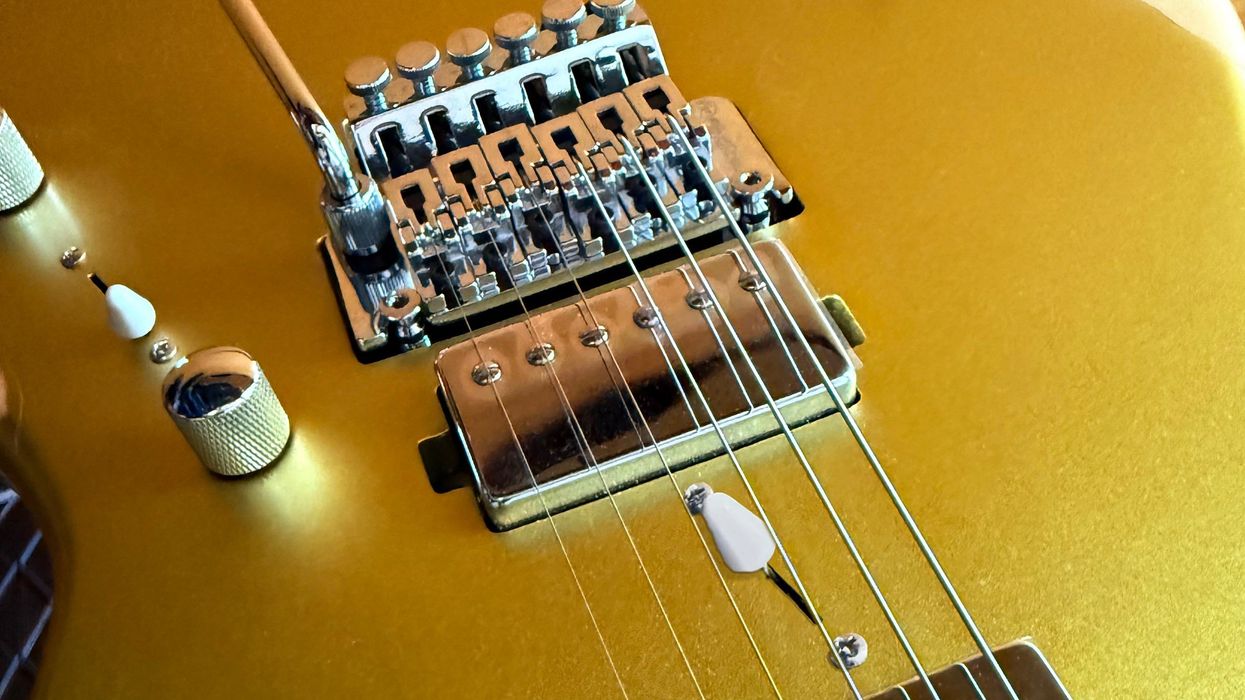
Over the years I’ve often been asked for advice about how to “get into the business” of either the playing or building of guitars. Despite my reluctance to toss anyone into the hellhole pit that is either of these two endeavors, I do my best to help. That isn’t to imply that building guitars or playing music isn’t satisfying—it most certainly can be. In fact, many of us have built fulfilling and profitable careers in both of these trades, not to mention made lifelong friends. What are you hoping for? Is this going to be your job, with hopes that it won’t seem like drudgery? Do you just like to mess around with gear and wonder what it would be like to do it for pay? Like almost everything in life, it’s the managing of expectations that’s at the heart of the matter.
If it’s money you’re after, there are people more qualified to guide you than me. Yes, I’ve managed to scrape together a living while seemingly avoiding the grind of a “normal” job, but it hasn’t been a cake walk. I’d be afraid to add up the hours I’ve spent doing things I would have rather not had to do. I call it the 80/20 rule. You spend 80 percent of your time doing stuff you’d rather not do, and 20 percent doing the things you love—and I’m being generous here. If that seems like a normal job to you, you’d probably be correct. But despite all of that, let’s talk about how to get started anyway.
If you want to follow your muse and cut your own path, approach things like an artist who dropped out of business school. Be prepared to use your truncated education on 80 percent of the work, and let your freak flag fly on the 20 percent that makes you be you. Not everything you create will solve problems and answer questions for your customers and fans, but that’s not the point—at least in the creative part. Don’t worry, your rational self will be waiting down the line to reveal the cold hard truth later.
“Being a creative person is a series of trial-and-error episodes as much as any kind of formal schooling.”
In art critic Jerry Saltz’s book How to Be an Artist, he spells out how to discover your path—a sort of step-by-step guide to making the right kind of “mistakes” that bring you to the place where you know and understand how to be uniquely you. In fact, you might want to stop reading my drivel and go buy his book now. That gets us both off the hook.
Saltz’s process seems very familiar to me. You see, being a creative person is a series of trial-and-error episodes as much as any kind of formal schooling. It’s good to learn the history of your craft—all of it. Learn the way artists look at the world. Try to imagine how the constraints of what has come before benefit and hold us back. You can’t break the rules unless you know them and why they exist. There are conventions that should be questioned, and others that are the bedrock of the game you are playing. Learn how to tell the difference.
Maybe you’ve heard that there are only seven basic story arcs: overcoming the monster, rags to riches, the quest, voyage and return, comedy, tragedy, and rebirth. But we all know that within these themes there are infinite possibilities. That’s your ticket. That’s where your personality and character carve out your unique vision. I like to think of guitars (and songs) as story arcs. There may be only a few archetypes, and almost everyone follows them, but what’s important is the way you tell the story. On a guitar, you shouldn’t just decide to put a toggle switch in the middle of the fretboard because you want to be different, but you can decide to make that switch do something that hasn’t been done. I usually stop at that point and ask the 80 percent dude in me if this will actually help anyone, although I am free to ignore the answer if it helps to tell the story I am telling.
In the end, if you pay attention to what you like, the story you are telling will be a reflection of you. When that story makes sense to your audience, too, you’re in business. And that’s how you make a life as an artist
System of a Down's Daron Malakian Rig Rundown
The metal giants return to the stage with a show powered by gold-and-black axes and pure tube power.
Except for two new singles in 2020, alt-metal icons System of a Down haven’t released new music in 20 years. But luckily for their fans, System—vocalist Serj Tankian, guitarist/vocalist Daron Malakian, bassist Shavo Odadjian, and drummer John Dolmayan—took their catalog of era-defining, genre-changing hard-rock haymakers on tour this year across South and North America.
PG’s Chris Kies connected with Malakian onstage at Soldier Field in Chicago ahead of System’s second show at the football stadium. Malakian and his tech, Patrick Lachman, explained how some color-coded Gibson, Ibanez, and Friedman gear give Malakian the fire he needs to burn through the band’s legendary set.
Brought to you by D’Addario.
SG With SDs
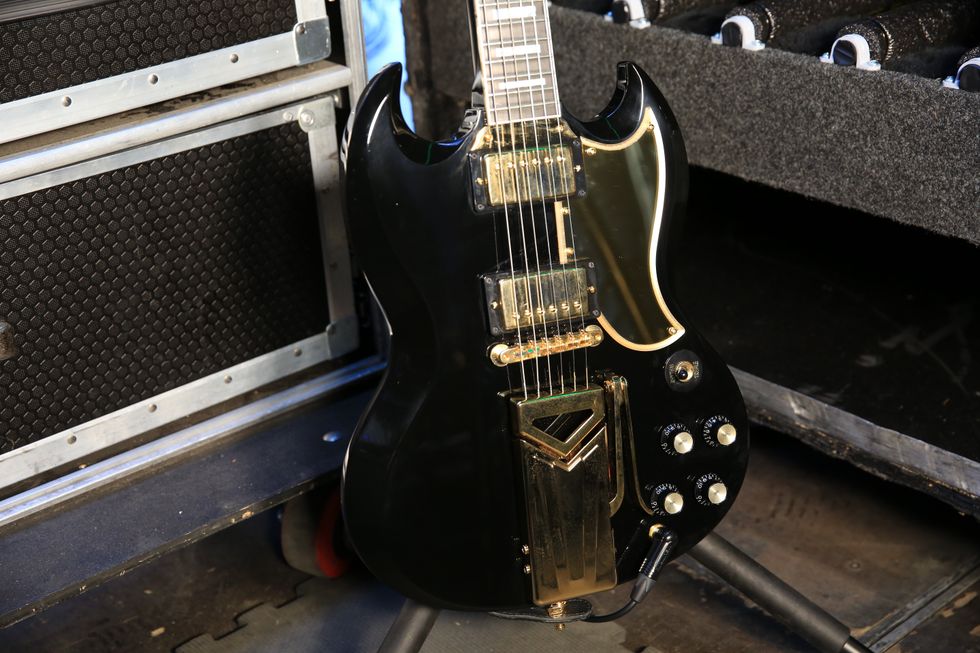
This Gibson SG is brand new and “hot off the presses,” per Malakian’s tech, Lachman. Built in Gibson’s Custom Shop, it’s got Seymour Duncan Custom Shop pickups. On this run, he starts shows on this guitar, and will typically switch things up after about 10 songs.
Malakian plays custom, extra-pointy Dunlop picks, and runs all his axes with a custom set of Ernie Ball strings (.010–0.50). System’s catalog, and therefore Malakian’s guitars, are predominantly in drop-C tuning.
Freeze!
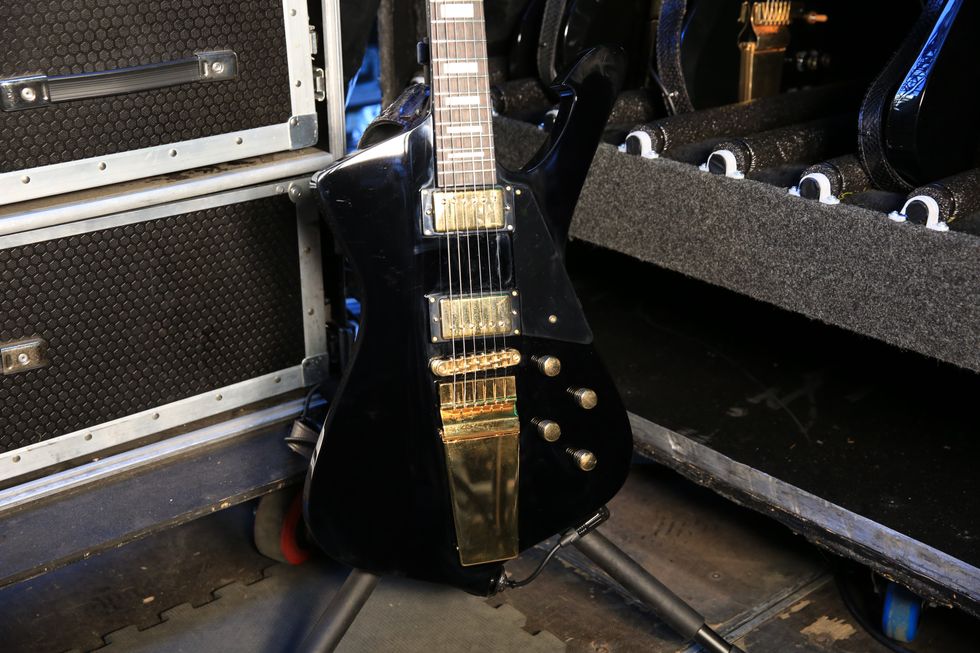
Next up during the set, Malakian will turn to his iconic Ibanez Iceman, one of his most heavily leaned-upon toys during this tour. This one has black “secret ninja binding,” his tech quips, virtually invisible to all but Malakian. It’s wired with Seymour Duncan Custom Shop Pearly Gates pickups.
B.Y.O.V.
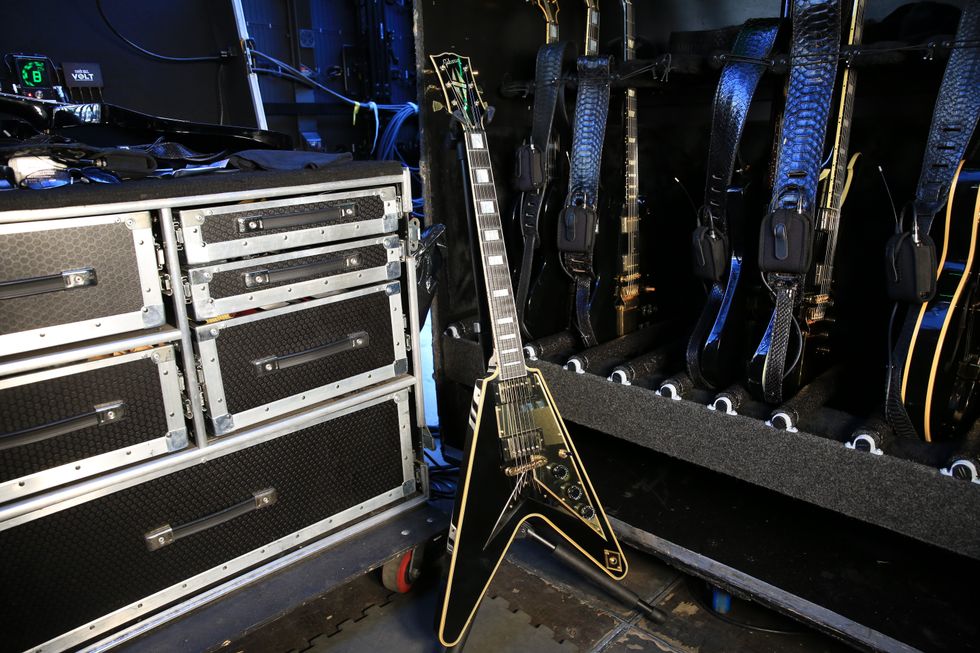
Malakian always liked how Albert King’s Flying V looked with its Les Paul-style headstock, so when Gibson was making him a V, he requested that it be outfitted with the same look. This one’s rocking a pair of Seymour Duncan Saturday Night Special pickups.
Semi-Hollow Star
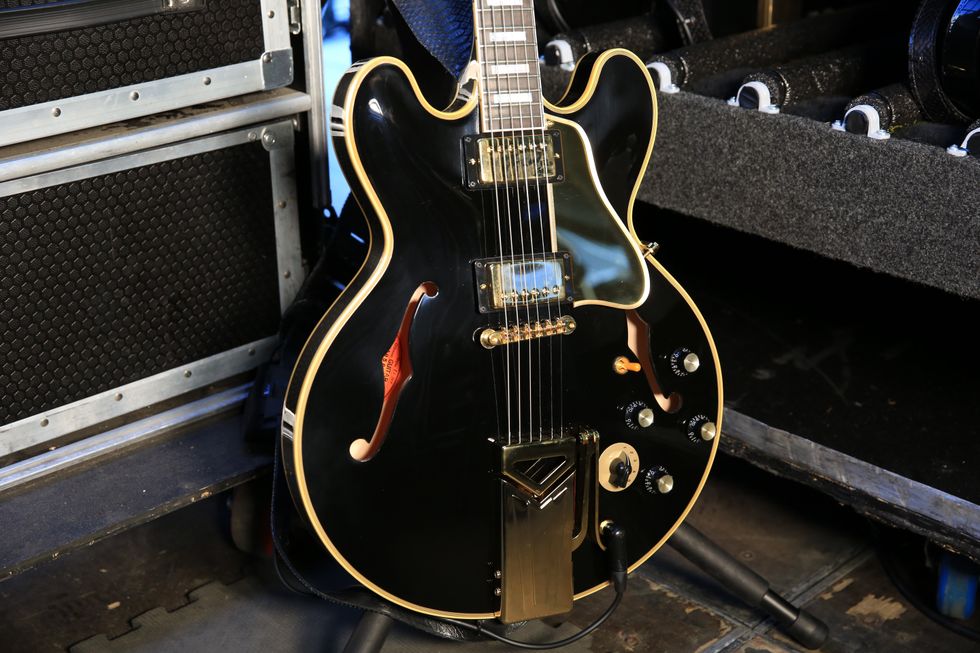
This Gibson ES-335, dressed in the same black-and-gold scheme as all of Malakian’s guitars, also came fresh from the Custom Shop for this run of shows.
Old and New, All Tube
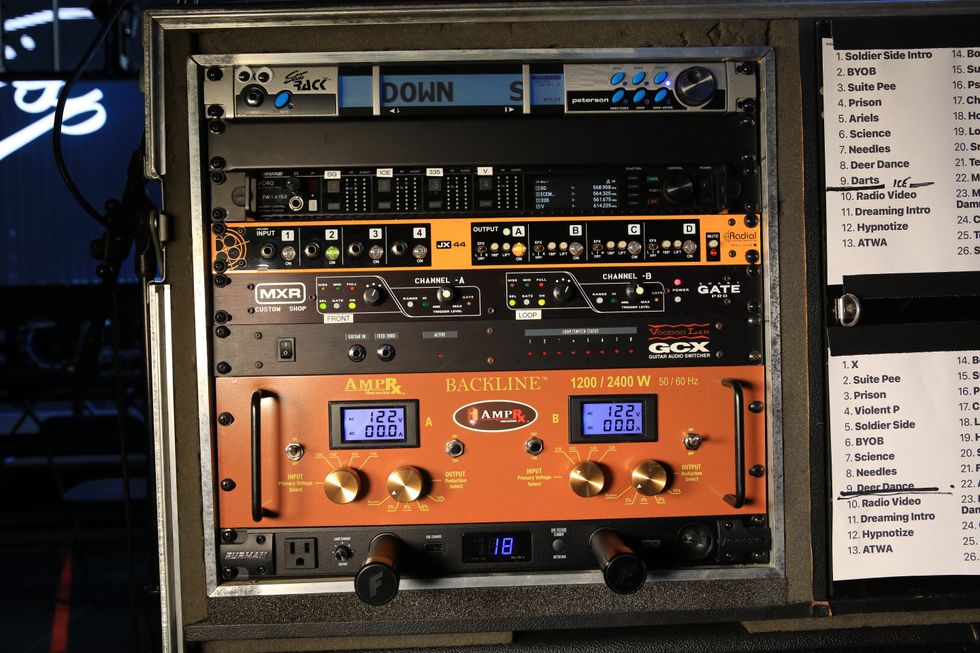
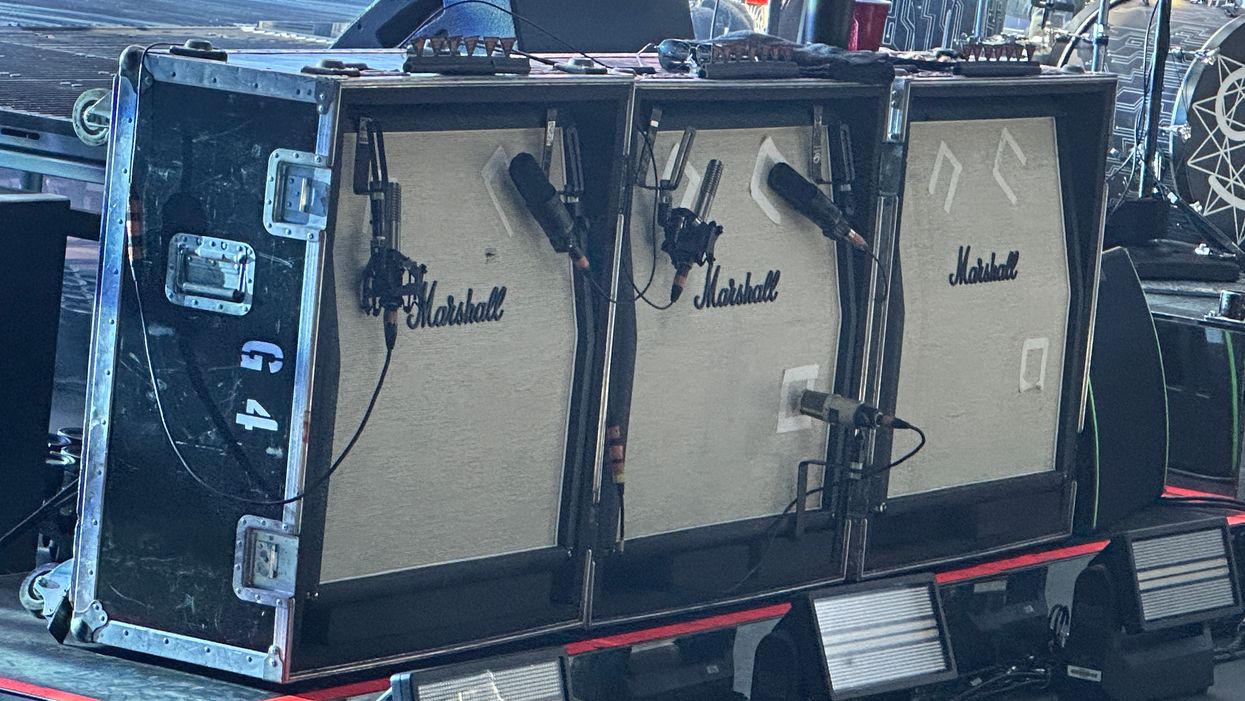
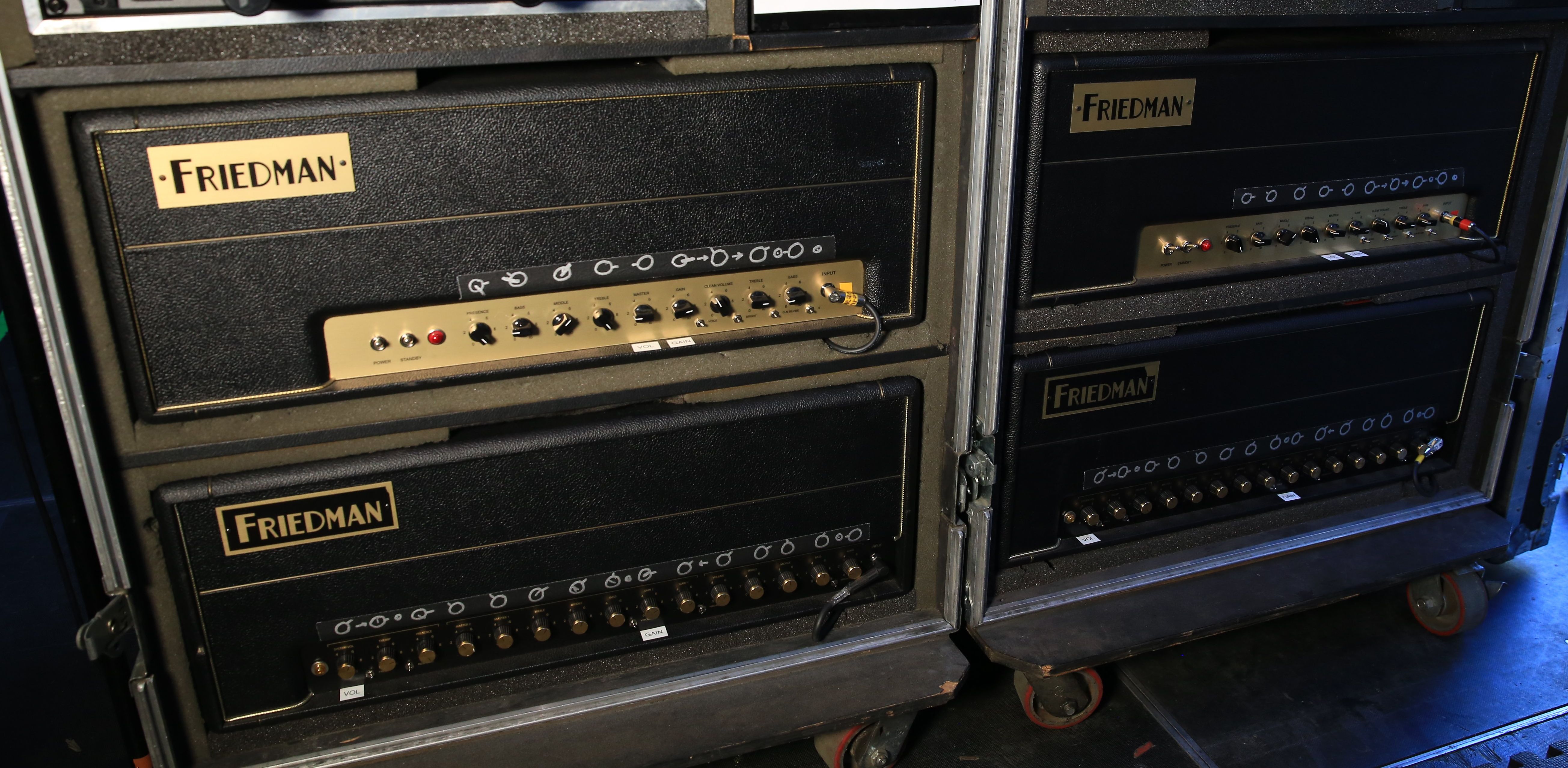
Malakian doesn’t have anything against modeling technology, but he prefers to keep things old-school. He runs two generations of Friedman BE-100 heads at the same time: The newer BE-100 Deluxe head (below) is used for dirty tones, while the first-gen BE-100 (above) stays dialed for cleans. They’re connected to two Marshall 4x12 cabinets onstage, dedicated to either the clean or overdriven signals. The speakers are Celestion G12M-70s.
Loaded onto Malakian’s rack above the amp heads are a Shure AD4Q, Radial JX 44, MXR Smart Gate Pro, Voodoo Lab GCX, AmpRx Backline, and Furman PL-Pro DMC.
Daron Malakian’s Pedalboard
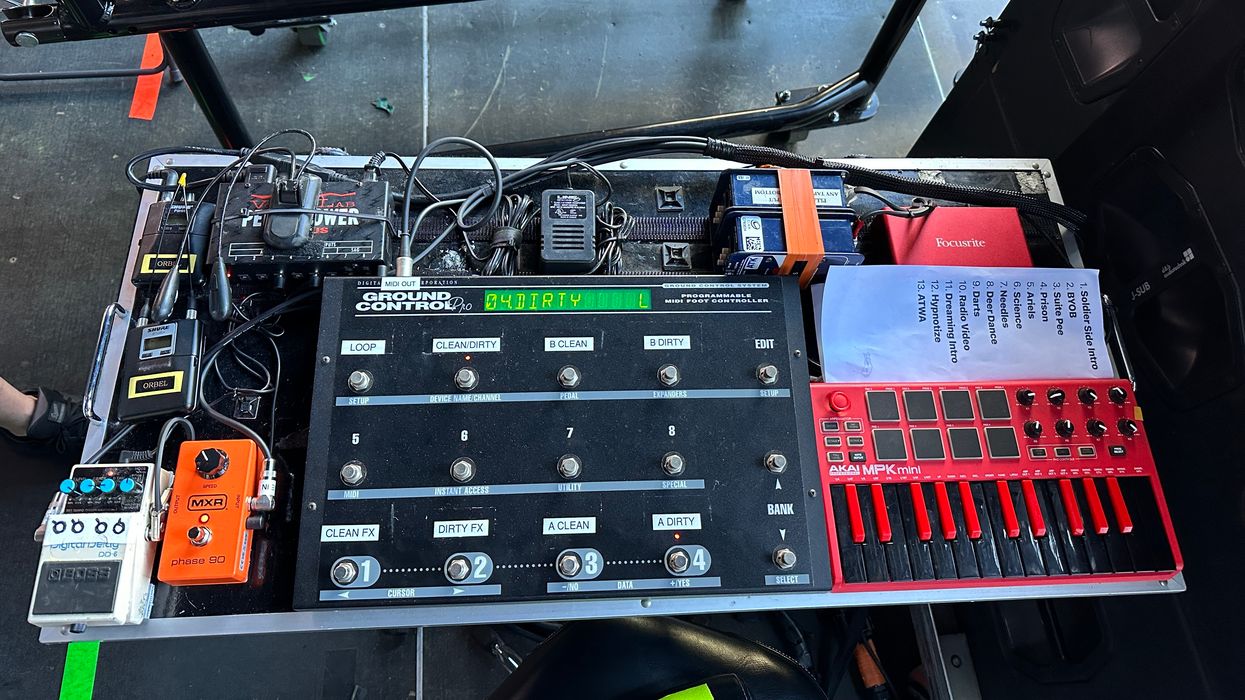
Malakian’s switching is handled backstage by his Scars on Broadway bandmate Orbel Babayan via this board. In addition to a Voodoo Lab Ground Control Pro switcher, Akai MPK Mini, and Scarlett Focusrite interface, the board is dead simple, with just an MXR Phase 90 and Boss DD-6 delay. No dirt pedals needed; all Malakian’s drive comes from the Friedman. A Voodoo Lab Pedal Power 2 Plus fires up the affair.

Ernie Ball Custom Set (.010-0.50)
Peter Frampton & Warren Haynes: 'The Art Of Music' Debuts Sept 6 on Public TV
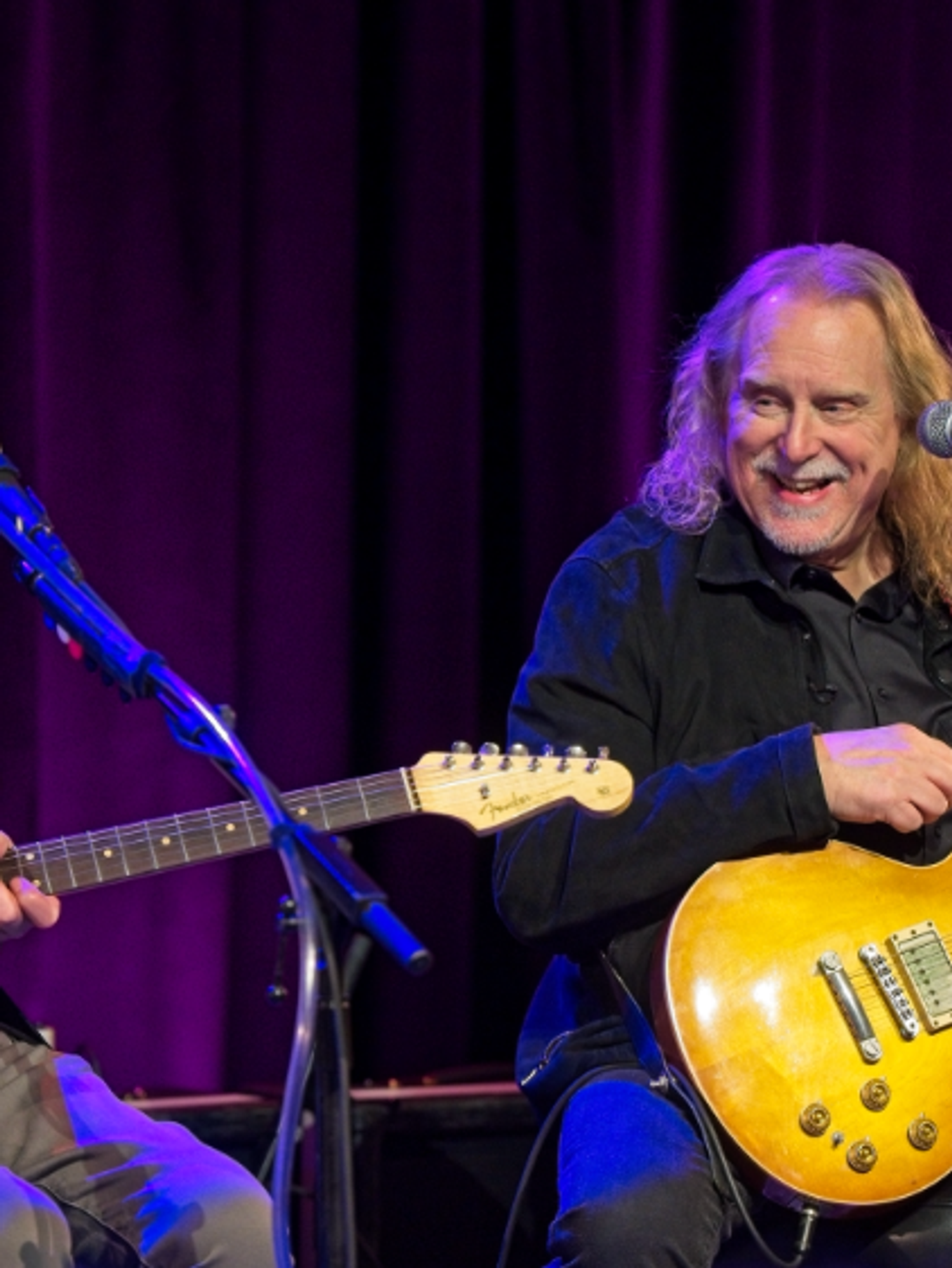
Rock & Roll Hall of Fame inductee, GRAMMY® Award-winning musician and one of the most celebrated artists in rock history, Peter Frampton, is the latest artist featured in the new public television series The Art of Music premiering September 6, 2025. Presented by United MileagePlus® Cards from Chase and filmed in front of a live invited audience at The Metropolitan Museum of Art in New York City, Frampton is interviewed by guitarist, singer and songwriter Warren Haynes.
As part of this unique series, Haynes led a conversation with Frampton about his musical journey, sharing insights into his creative processes. The discussion intertwined some of Frampton’s timeless hits such as “Do You Feel Like We Do”, “Baby I Love Your Way”, and “Show Me The Way”.
“It was wonderful performing for The Art of Music series, it’s such a unique way of putting art and music together and to have done this at The Met, what an honor,” says Frampton.
The Art of Music, created and executive produced by iMaggination’s Don Maggi, was created to give viewers a rare look inside the artists’ lives and their creative practice at the prestigious Metropolitan Museum of Art. In this episode, after nearly 50 years since Frampton Comes Alive! was released, which remains one of the top-selling live records of all time–selling over 17 million worldwide, the celebrated guitarist shares stories about his vast catalog and significant moments in his career.
“We're excited to share this new episode of The Art of Music featuring Peter Frampton and Warren Haynes,” says Maggi. “The combination of these two legends together on stage within the walls of the prestigious Metropolitan Museum of Art offers audiences a unique and intimate look inside Frampton's historic journey through storytelling and performance.”
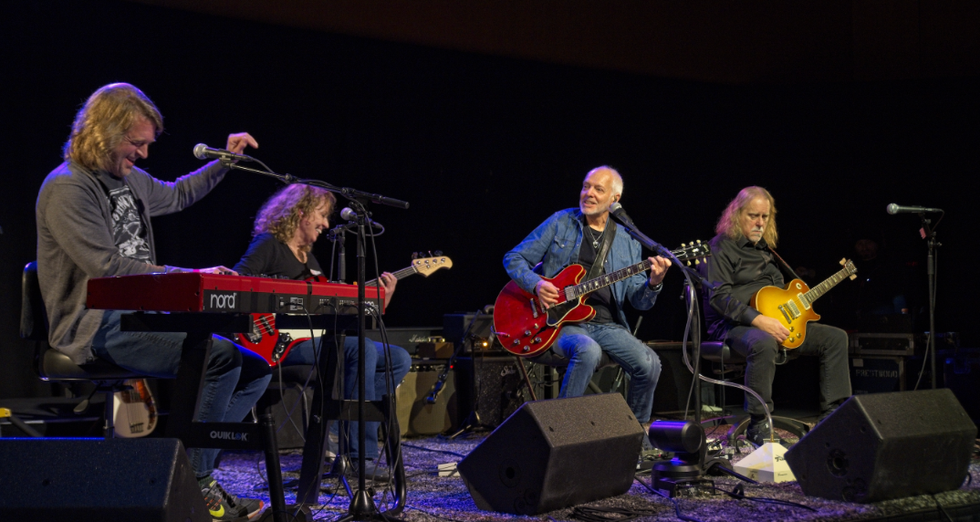
“We were thrilled to welcome Peter Frampton to The Met for an unforgettable visit. Sharing our newly acquired collection of American guitars with him was a true privilege, made all the more special as Frampton recounted his journey as a guitarist and performed some of his most iconic music." - Jayson Kerr Dobney, Frederick P. Rose Curator in Charge of the Department of Musical Instruments at The Met
Frampton’s episode of The Art of Music will air on public television stations nationwide beginning September 6, 2025. Fans may also watch on The Art of Music website or stream on the PBS app.
The national public television World Channel will air the episode Saturday, October 4 at 7pm ET, with a repeat on Monday October 6 at 5am ET (adjust by time zone). Visit worldchannel.org to find your local World Channel station. The program will air on the
All Arts Channel and on the All Arts app in the New York Metro area on Saturday, October 25 at 9 pm.
This special interview and performance featuring Peter Frampton presented by United MileagePlus® Cards from Chase was an unforgettable occasion for Chase United Cardmembers who were invited to attend the intimate live taping. The United MileagePlus® Cards from Chase provide Cardmembers with access to exclusive events and experiences in addition to many reward and travel benefits with United Airlines. Underwriters for The Art of Music are The Mark Hotel and SUNDRAGON.
Additional artists to be announced for the series soon. For more information, visit https://theartofmusic.org.
PRS Guitars Brings Back the Mira as an S2 594
PRS Guitars today announced the return of the Mira model to the Maryland factory line, now with the 24.594” scale length. This new iteration, available in both gloss and satin finishes, will be a regular offering in the S2 Series.
The 22-fret S2 Mira 594 covers a wide range of styles, including rock, blues, garage, and punk. Pairing its all-mahogany construction with PRS 58/15 LT vintage-voiced pickups results in warm, focused midrange. The humbuckers are paired with two mini-toggle switches to individually tap the pickups, delivering both authentic humbucking and chimey single-coil sounds.
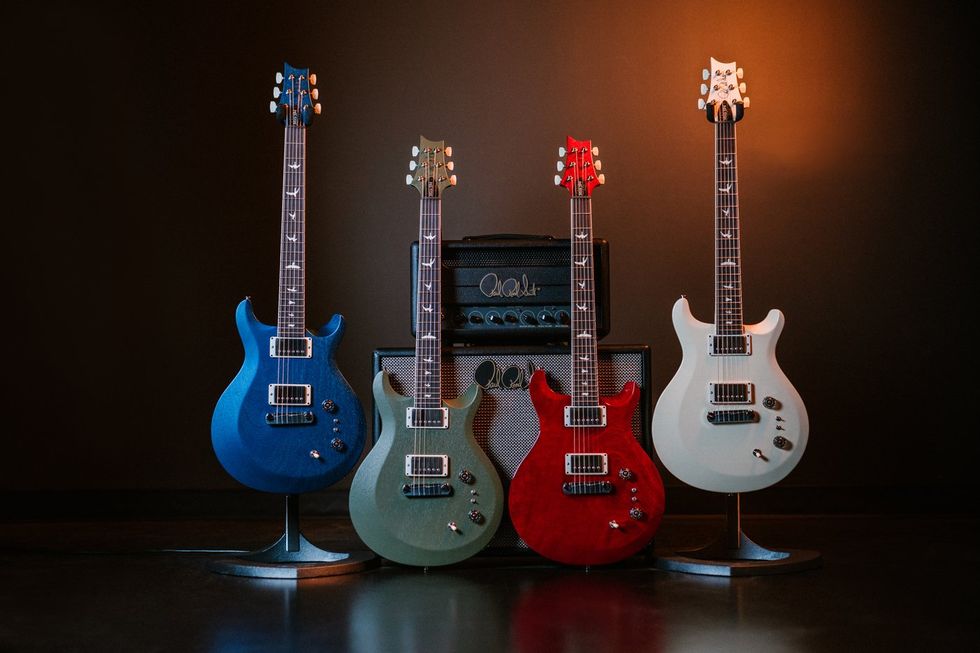
“The Mira has had an interesting history over the course of the last 17 years, but I don’t think it found its true voice until now,” said PRS Guitars Director of Sales, Jim Cullen. “The S2 Mira 594 combines our 24.594” scale length with a Pattern Thin neck shape and a very simple and straight forward feature set that provides an incredibly lively, simple-to-use tool to create music. I hope you are as inspired as we are with the newest evolution of this classic model.”
The S2 Mira 594 is available in: Antique White, Black, Dark Cherry Sunburst, Platinum Metallic, Vintage Cherry, and debut color Black Rainbow Holoflake.
The S2 Mira 594 Satin features the PRS “sinky” satin nitro finish, and is available in: Matcha Green, Mavis Mint Metallic, Metallic Midnight, Dark Cherry Sunburst, Red Apple Metallic, and debut color Cloud Burst.
The Mira was first introduced in 2007 as an all-mahogany pickguard guitar with moon inlays, 24 frets, 25" scale length, a stoptail bridge, and a single mini-toggle. It has appeared across all of the Series and in various configurations, including the popular Mira X. In 2013, the Mira was moved from Core and was one of three models to launch the S2 Series. It was last offered as an S2 in 2018, becoming part of the SE Series from 2020-2023.
PRS Guitars continues its schedule of launching new products each month in 2025. Stay tuned to see new gear and 40th Anniversary limited-edition guitars throughout the year. For all of the latest news, click www.prsguitars.com/40 and follow @prsguitars on Instagram, Tik Tok, Facebook, X, and YouTube.
PRS Guitars Brings Back the Mira as an S2 594
PRS Guitars today announced the return of the Mira model to the Maryland factory line, now with the 24.594” scale length. This new iteration, available in both gloss and satin finishes, will be a regular offering in the S2 Series.
The 22-fret S2 Mira 594 covers a wide range of styles, including rock, blues, garage, and punk. Pairing its all-mahogany construction with PRS 58/15 LT vintage-voiced pickups results in warm, focused midrange. The humbuckers are paired with two mini-toggle switches to individually tap the pickups, delivering both authentic humbucking and chimey single-coil sounds.

“The Mira has had an interesting history over the course of the last 17 years, but I don’t think it found its true voice until now,” said PRS Guitars Director of Sales, Jim Cullen. “The S2 Mira 594 combines our 24.594” scale length with a Pattern Thin neck shape and a very simple and straight forward feature set that provides an incredibly lively, simple-to-use tool to create music. I hope you are as inspired as we are with the newest evolution of this classic model.”
The S2 Mira 594 is available in: Antique White, Black, Dark Cherry Sunburst, Platinum Metallic, Vintage Cherry, and debut color Black Rainbow Holoflake.
The S2 Mira 594 Satin features the PRS “sinky” satin nitro finish, and is available in: Matcha Green, Mavis Mint Metallic, Metallic Midnight, Dark Cherry Sunburst, Red Apple Metallic, and debut color Cloud Burst.
The Mira was first introduced in 2007 as an all-mahogany pickguard guitar with moon inlays, 24 frets, 25" scale length, a stoptail bridge, and a single mini-toggle. It has appeared across all of the Series and in various configurations, including the popular Mira X. In 2013, the Mira was moved from Core and was one of three models to launch the S2 Series. It was last offered as an S2 in 2018, becoming part of the SE Series from 2020-2023.
PRS Guitars continues its schedule of launching new products each month in 2025. Stay tuned to see new gear and 40th Anniversary limited-edition guitars throughout the year. For all of the latest news, click www.prsguitars.com/40 and follow @prsguitars on Instagram, Tik Tok, Facebook, X, and YouTube.
Question of the Month: The Pedals of Our Dreams
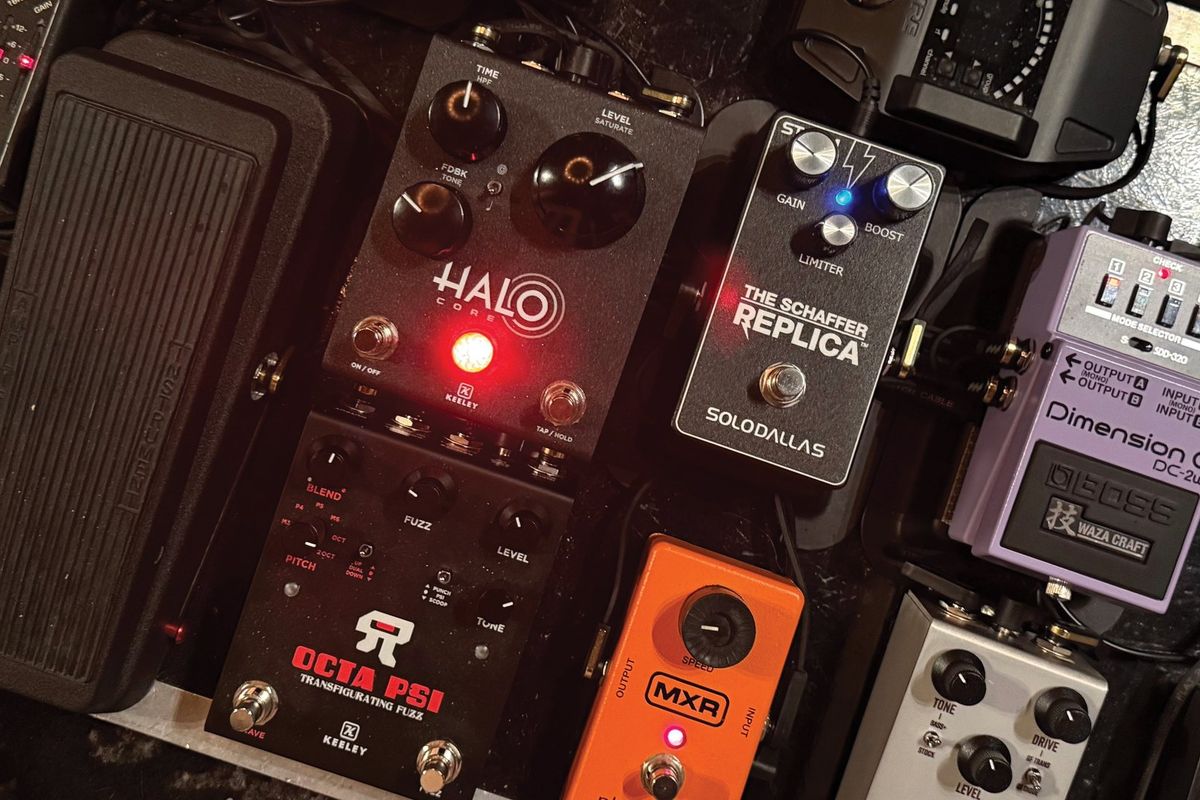
Question: What pedal doesn't exist now that you hope gets built in the next year?
Guest Picker - Penelope StevensMotherhood, Penny & the Pits
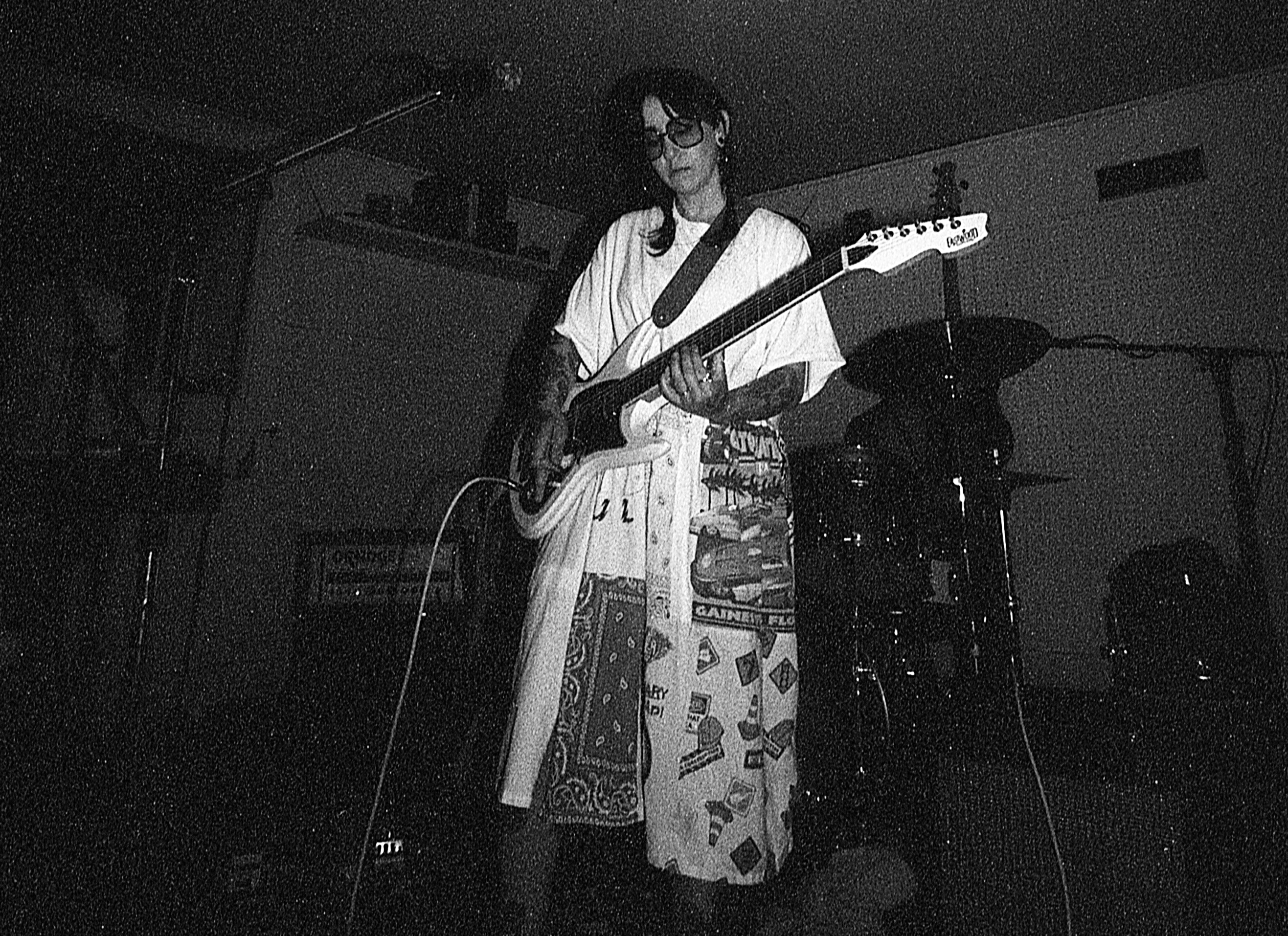
A: I’m a synth player before a guitarist, and for years I’ve been trying to figure out a way to play my synths through my guitar … or my guitar through my synths? I know there are pedals that can make your guitar sound like a synth, even some that can emulate particular models, but I want a pedal that I can connect to any synth, and it can feed whatever patch I’ve built through my chain. I have a Volca Keys that makes absolutely GNARLY tones, and for a while I was trying to figure out a way to have it in my pedalboard as an effect. Alas, this is quite beyond my skillset—I’m no electrical engineer—but the dream has never died. Imagine being able to shape your guitar tone with as many possibilities as on an analog synth! Can somebody make me this pedal please?
Obsession: When I’m not touring, I’m a cocktail bartender. (PLEASE don’t call me a mixologist.) My current obsession is this margarita riff I’ve been working on: tequila blanco, amaretto, lime, and prickly pear shrub. I’m drinking this little number more than I should probably admit, especially as we fight a heat wave in eastern Canada. I’ve been making cocktails to go along with each song on my new album, and filming tutorials for each one on Instagram. The prickly pear margarita will be making an appearance soon!
Reader of the Month - Jin J. X
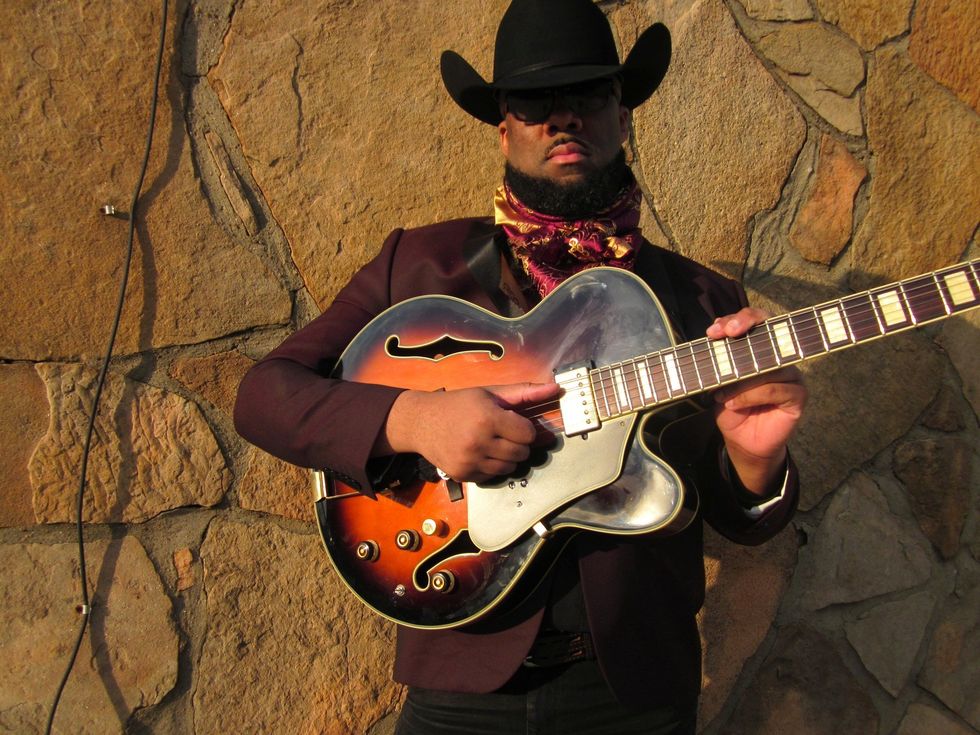
A: The out-of-production Boss VB-2. I absolutely love chorus and vibrato. I also love Boss. While I appreciate the CE-2w and absolutely love the upgrade/update, I just haven’t been able to connect with its counterpart, the VB-2w. I’ve tried multiple times to buy that pedal but to no avail. The Behringer UV-300 is analog and sounds absolutely perfect, though I’ve found that every single one I’ve bought over the years has a switch failure, and many modders can’t really work with them. Also, there are other great vibrato pedals, though without the “rise” function of the VB-2, I don’t find them as useful. I’ve heard the BYOC folks make one, though they seem to sell very quickly. I hope Boss, or someone, makes a true-blue VB-2-style pedal, with the right analog chip, that is built with solid components.
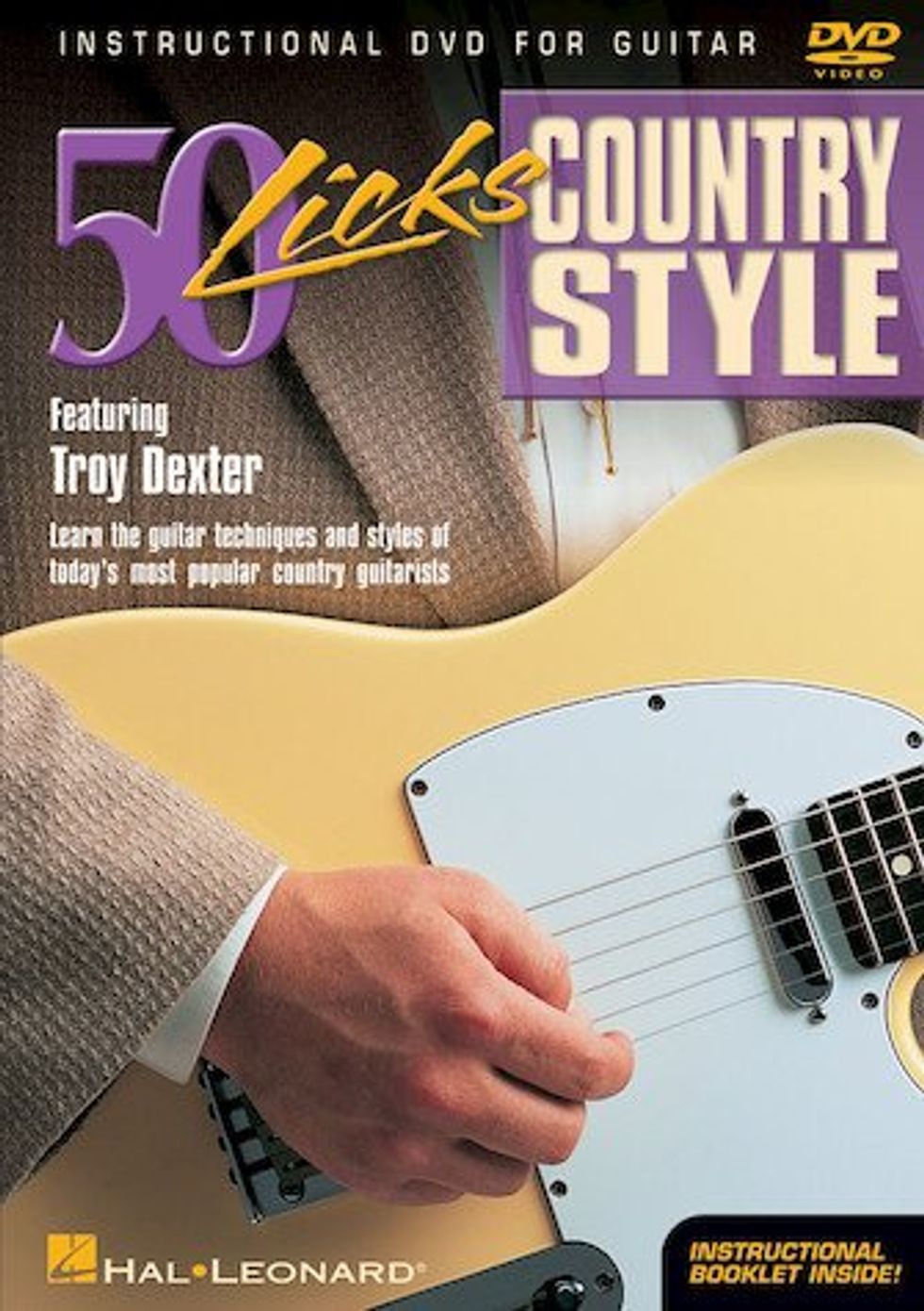
Obsession: Country-style guitar. Fifteen years ago, I bought a DVD called 50 Licks Country Style featuring Troy Dexter. After all these years, I finally pulled it out of the plastic and have begun trying to work those up. In many ways, the licks revolve around dominant 7 chords, so, in some ways, these country licks sound like jazz licks in the bridge position. It’s like a two-for-one special learning them. I also recently released an Afro-futurist/country album earlier this year called The Barefoot, Pregnant, Neck Beard, Marital Bed String Band, so I’ve been playing and promoting that record and putting my country licks to good use.
Brett Petrusek - Director of Advertising
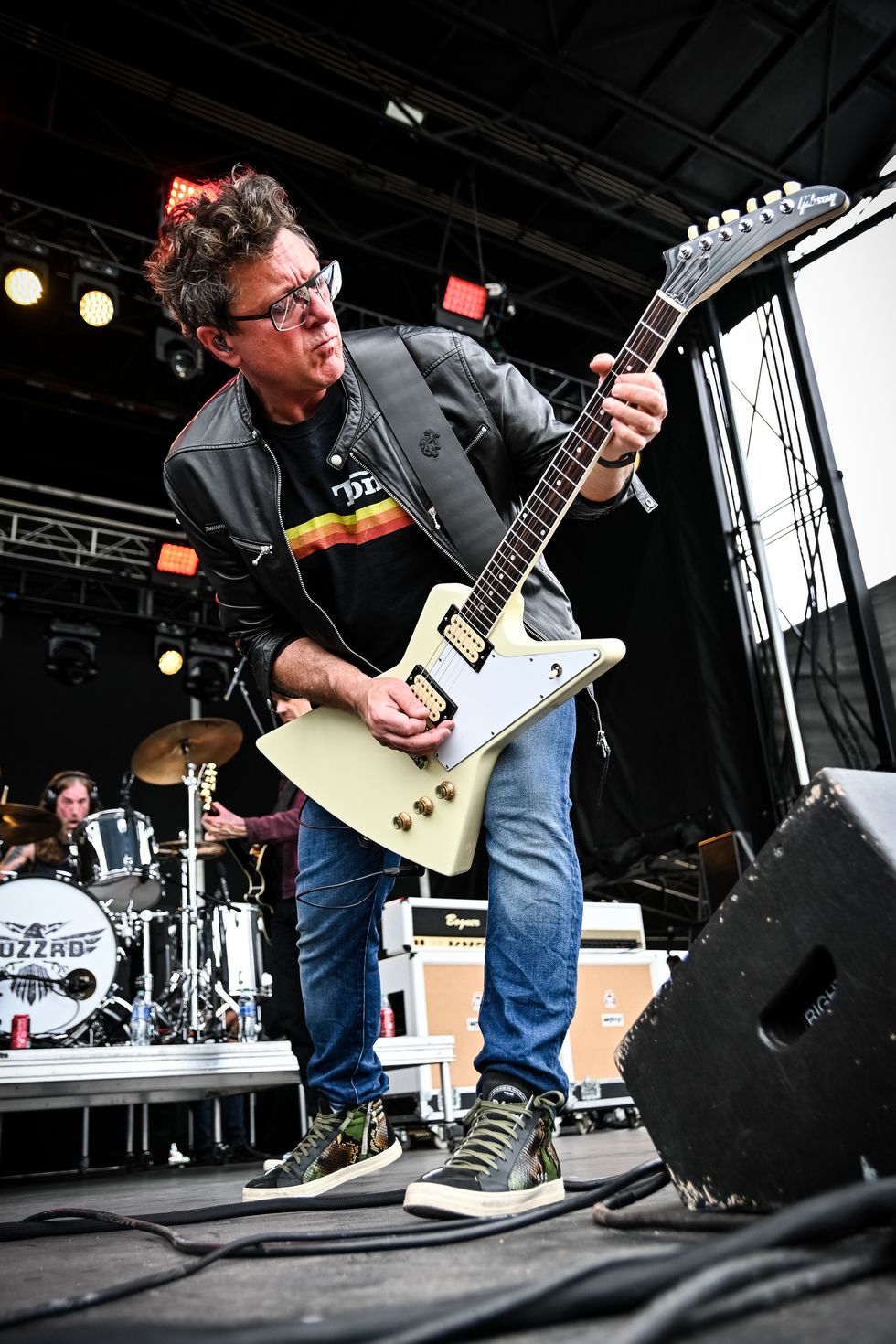
A: I’d love a Boss Waza Craft Dimension C with a mix control knob, or better yet a Waza Craft reissue of the Digital Dimension with expanded tonal range, better filtering, fancy high-quality buffer, and with that ultra-low noise floor.
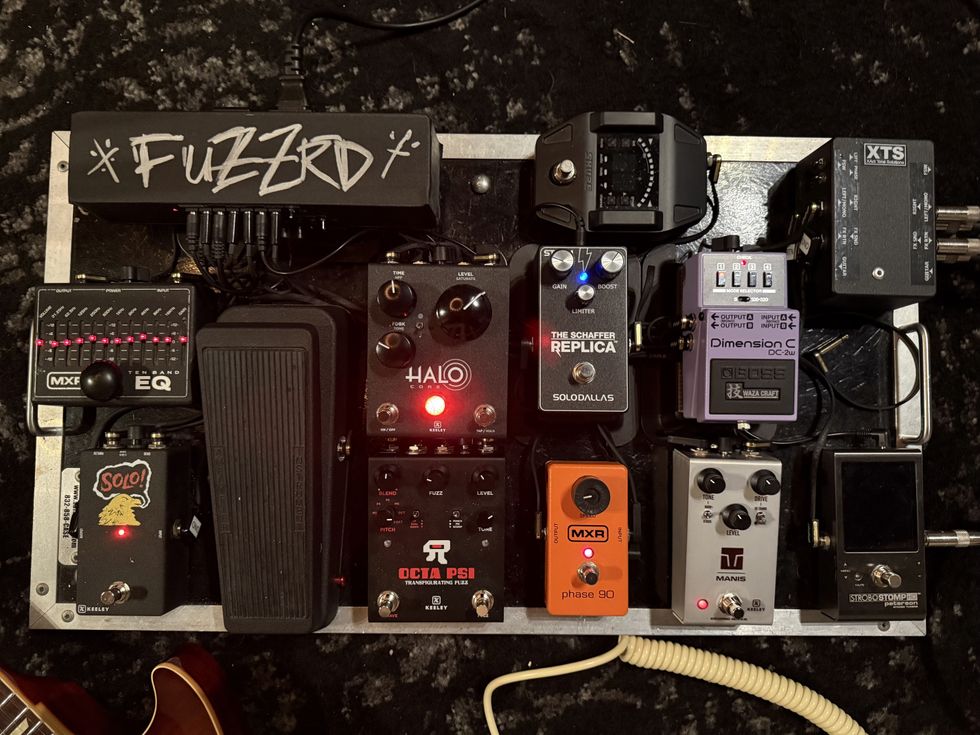
Obsession: Auditioning stereo modulation pedals. I use pedals like this in my live rig to split out in front of two big amps to expand the stereo field. I like the option of being able to keep it subtle and having easy access right on my pedalboard (old-school). It’s an art form to find modulation or doubler pedals that will do this into the front end of high-gain amps without a lot of hiss. I am currently digging the Mr. Black DoubleTracker Stereo; it can get insanely wide (especially in the effects loop). Maybe Keeley will make a stereo 30 ms in their new folded aluminum enclosures … I bet their fanbase would go nuts!
Nick Millevoi - Senior Editor
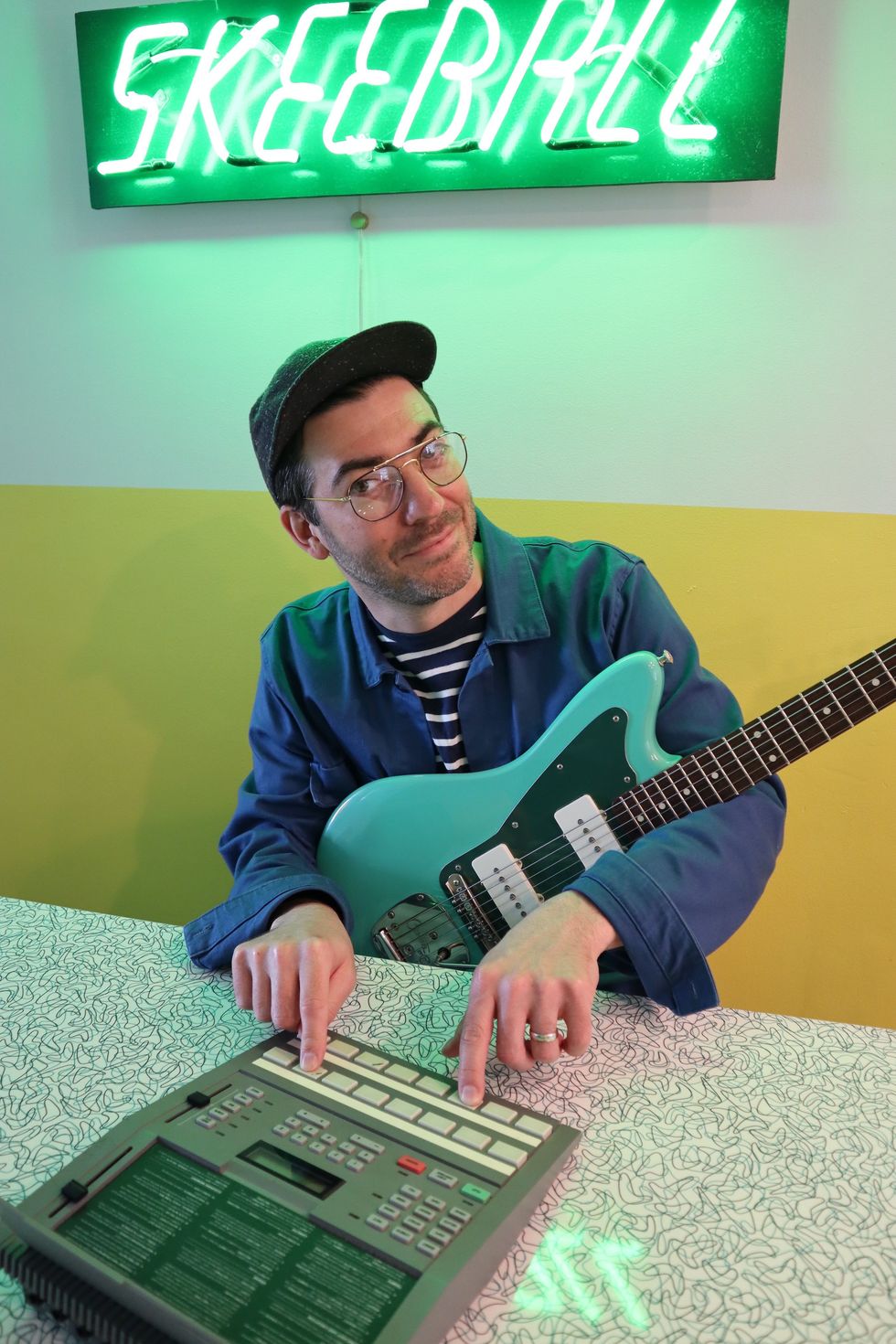
A: I’ve spent years longing for a pedal that captures the unique sonic capabilities of the Lexicon Prime Time. The Soundtoys PrimalTap plugin does an excellent job for working at home, but I dream of making those warm, ethereal sounds live (and the pricey rack unit itself isn’t practical for most of us). The Prime Time’s double delay lines with lo-fi-enhancing multiply knob sounds truly unique among delay units (dig it, Daniel Lanois enthusiasts), and its hip primary color knobs demand pedalboard real estate!
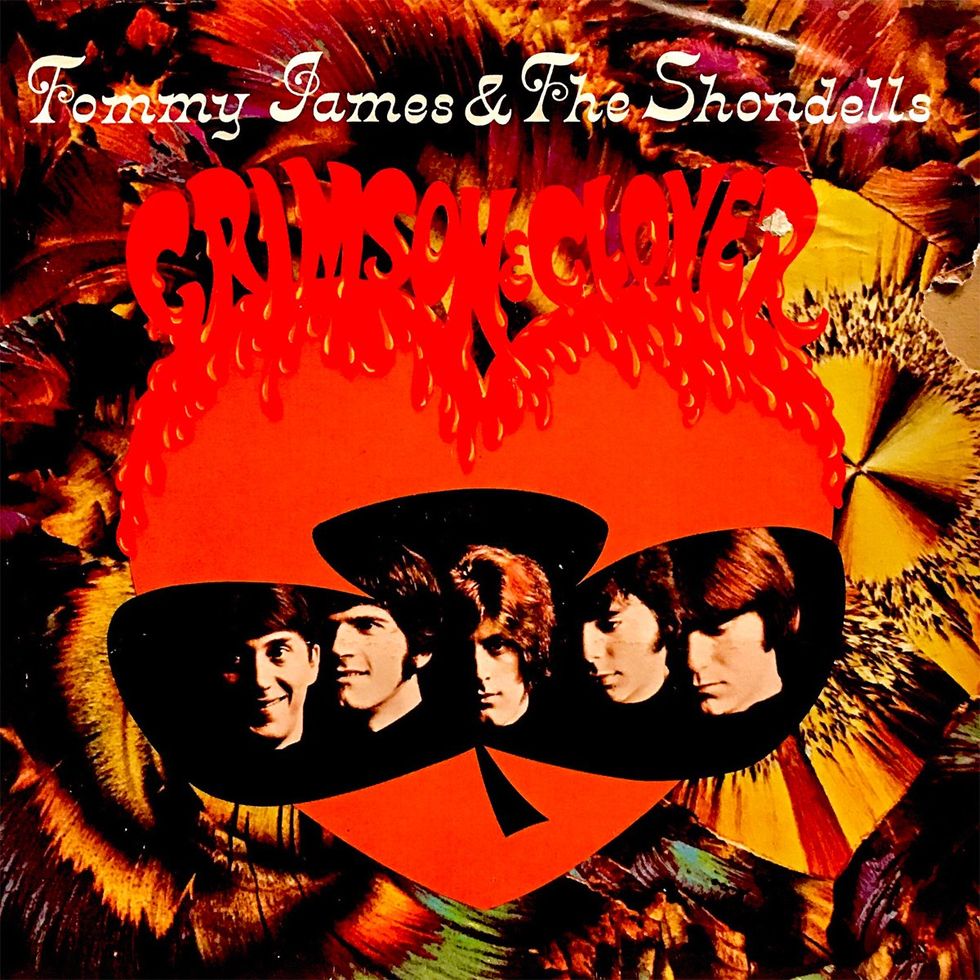
Obsession: I just caught Tommy James & the Shondells live and was blown away. Over the course of a relentlessly hit-laden set list—seriously, it was one after another: “Crystal Blue Persuasion,” “Mony Mony,” “Crimson and Clover,” “I Think We’re Alone Now,” “Draggin’ the Line,” and on and on—Tommy’s voice was in the finest form, driven by a powerful, heavy-grooving band. Go see ’em if you can!
T-Rex Effects Twin Blaze Giveaway from Guitars.net!

T-Rex Twin Blaze Giveaway from Guitars.net
T-Rex Twin Blaze
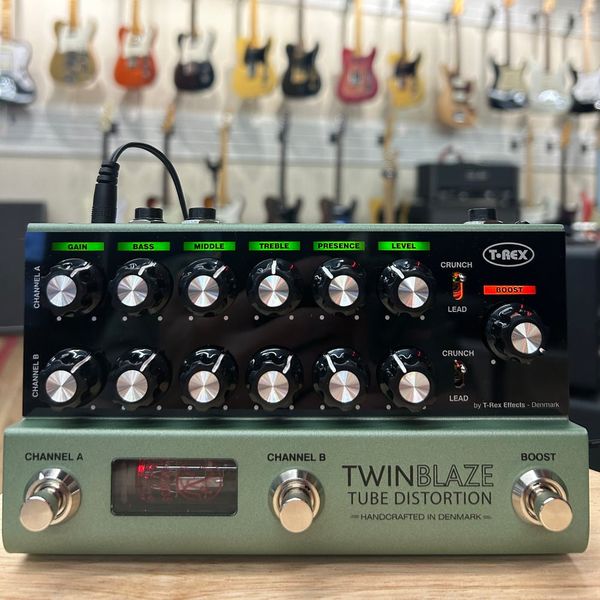
- Handcrafted in Denmark
- An identical two channel, tube driven Overdrive Distortion (12AX7A) spiced with the legendary T-Rex Tone and multiple functions.
- The extended tone control allows you to go from clear British sound to deep-end distortion, obtaining a variety of sound settings.
- Crunch and Lead setting for each channel, which goes from gentle, crispy blues to over the top lead sound.
- The emulated Speaker Simulation output is directed to the studio setup or other external effectS.
- A 20dB Clean Boost works individually to dial in the perfect solo level without changing the tone and gain structure.
- 12V power supply included.
.rbm-pick-card { --rbm-border: ; --rbm-accent: ; border: 2px solid var(--rbm-border, #e53e3e); border-radius: 10px; padding: 16px; background: #fff; font-family: inherit; position: relative; } .rbm-pick-badge { position: absolute; top: -10px; left: 12px; background: var(--rbm-accent, #e53e3e); color: #fff; font-size: 12px; line-height: 1; padding: 6px 10px; border-radius: 6px; font-weight: 700; } .rbm-pick-wrap { display: grid; grid-template-columns: 110px 1fr; gap: 16px; align-items: start; } .rbm-pick-img { aspect-ratio: 1 / 1; /* forces square crop */ overflow: hidden; border-radius: 6px; background: #f3f4f6; /* subtle placeholder */ } .rbm-pick-img img { width: 100%; height: 100%; object-fit: cover; /* crops without distortion */ display: block; } .rbm-pick-title { margin: 0 0 4px; font-size: 20px; font-weight: 800; color: #111; } .rbm-pick-sub { margin: 0 0 12px; font-size: 14px; font-weight: 700; color: #334155; } .rbm-pick-btns { display: grid; gap: 10px; max-width: 560px; } .rbm-pick-btns a { display: block; text-align: center; background: #000; color: #fff !important; text-decoration: none; padding: 12px 14px; border-radius: 8px; font-weight: 800; letter-spacing: .3px; } .rbm-pick-btns a span.price { text-transform: none; } .rbm-pick-btns a span.label { text-transform: uppercase; } /* Responsive */ @media (max-width: 560px) { .rbm-pick-wrap { grid-template-columns: 80px 1fr; } .rbm-pick-title { font-size: 18px; } }
T-Rex Twin Blaze
Sheptone® Unveils the 7078 Humbucker
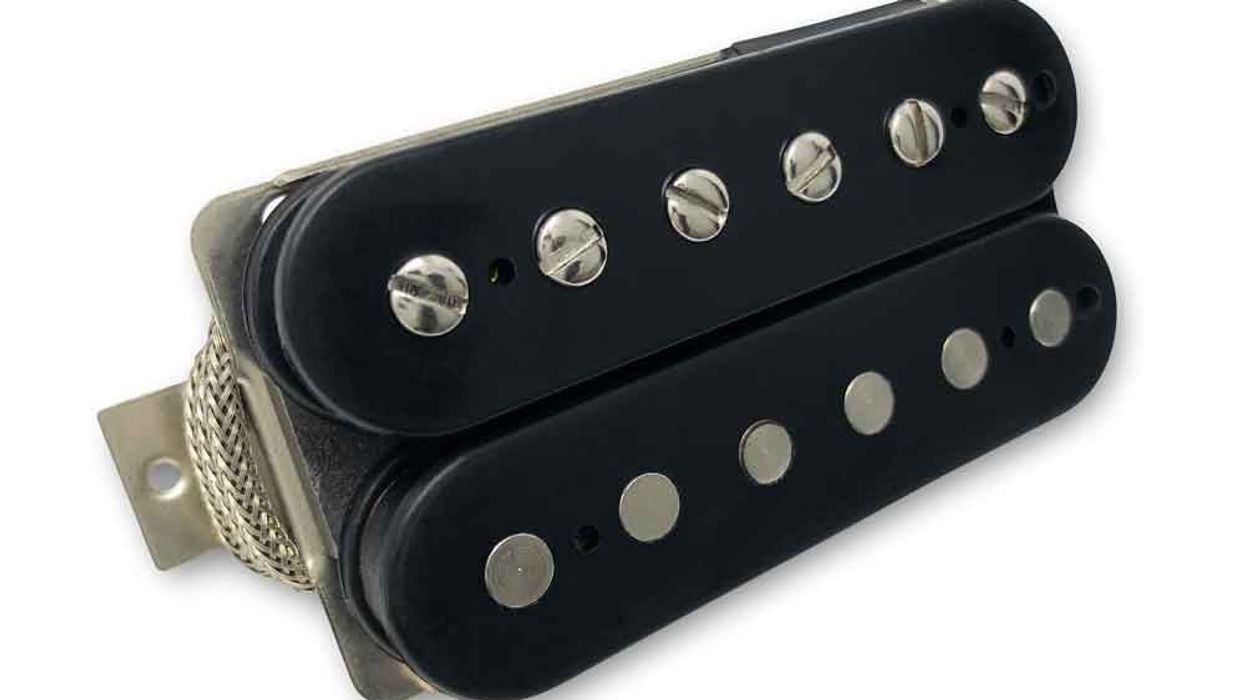
Sheptone® announces the 7078, a brand-new humbucking pickup inspired by the legendary tones that redefined rock guitar in 1978. Considered an industry secret for the past 18 years, Sheptone has been the “go to” for professional guitarists wanting to achieve that 1950’s tone that initially revolutionized electric guitar. The 7078 is the next step in the evolution of the Sheptone product line.
The 7078 pays homage to the iconic rhythm tones captured on Van Halen’s groundbreaking debut album. It was a sound that inspired generations of players and changed the way the world hears and plays the electric guitar. From the driving rhythms of You Really Got Me to the groove of Jamie’s Cryin’ and the raw fire of On Fire, the DNA of those unforgettable tracks lives on in the 7078.
At the core of that original tone was a stock 1975 Ibanez® Destroyer loaded with a Maxon® Super 70. The Sheptone 7078 recreates that magic with uncompromising authenticity, using the finest materials and painstaking craftsmanship. Each unit is hand-assembled by Sheptone owner and builder Josh Vittek, ensuring the detail and precision needed to deliver truly inspirational tone.
Using a rough cast, degaussed Alnico 8 magnet, the 7078 delivers articulate note definition and huge dynamics. The coils are computer wound with 42AWG plain enamel wire to Sheptone’s exacting specifications, ensuring consistent tone from pickup to pickup while staying true to vintage character. Sheptone’s proprietary double-black butyrate bobbins anchor the design, paired with German nickel silver baseplates that follow original-era specifications. Vintage braided hookup wire keeps period-correct authenticity, while the 49.2mm pole spacing and a resistance averaging around 7.7k complete the historically correct construction.
“This pickup is for a sure a future ‘secret sauce’ for many people's rigs. It really does things right! Harmonics in a second, the perfect amount of push on an amp yet while retaining complete clarity for clean playing to the most percussive metal rhythms my caveman wrist can throw at it. There's a certain sizzle near the mid highs that spikes your amp distortion in a way that I've not heard before. From the most basic of rock to the fastest, crustiest thrash, this pickup is quickly becoming my go-to,” said professional touring and studio guitarist, Charlie Bellmore of Jasta and Kings and Liars.
“The 7078 is more than a pickup. It’s a tribute to the sound that made so many of us pick up the guitar in the first place. Including me!” said Vittek. “I build each one by hand, with the same mindfulness and materials as I do all my other models. This may be the last pickup you’ll ever need… unless, of course, you own more than one guitar.”
The Sheptone 7078 is available now directly from Sheptone and through select dealers worldwide.
For more information, visit www.sheptone.com

